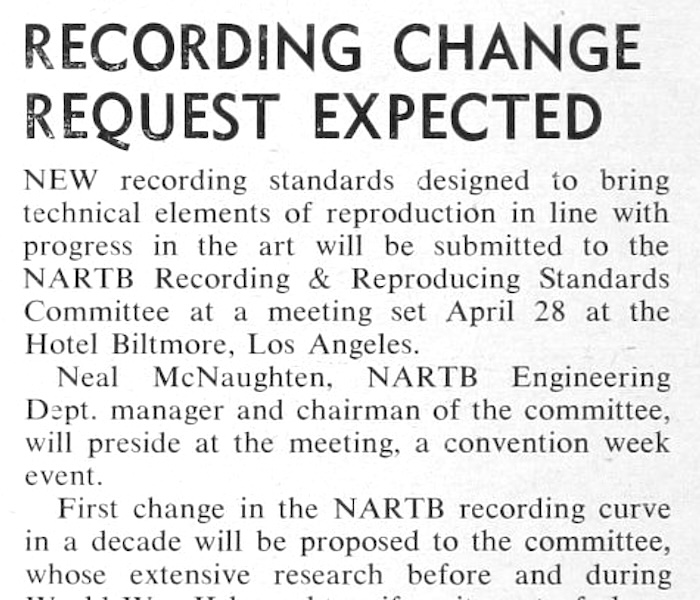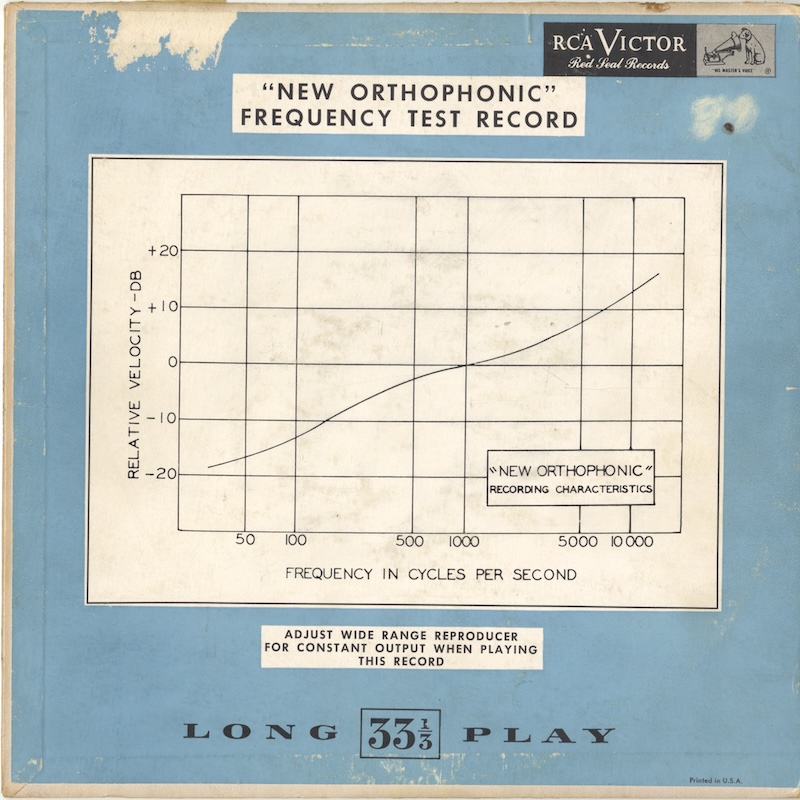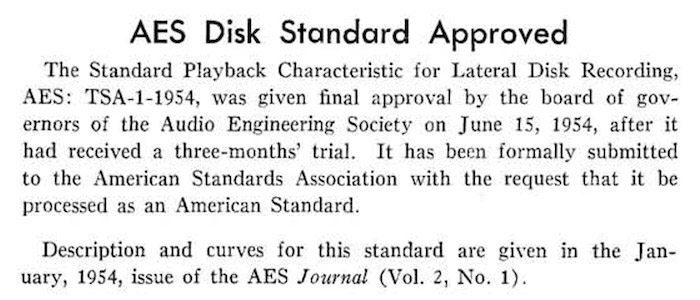EQカーブの歴史、ディスク録音の歴史を学ぶ本シリーズ。前回 Pt.17 では、1948年〜1953年(つまり1954年のRIAA規格策定前)の、米国における民生用レコードのEQカーブの状況を調査し学びました。
On the previous part 17, I learned the situation of the consumer records in the U.S. since 1948 until 1953 (i.e. before the RIAA Standard was formulated in 1954), especially the disc EQ curves used for those records manufactured in the U.S.
また、ハイファイブーム勃興期の当時に販売されていたアンプの、マグネットカートリッジ用のフォノイコについても調査しました。
At the same time, I did a brief research of phono EQ units (for magnetic cartridges) in the amplifiers that were sold in the era, when the rise of “Hi-Fi” movement became obvious.
今回の Pt.18 では、ついに、1953年NARTB規格、1954年改訂AES再生カーブ、1954年RIAA規格の成立のストーリーに入ります。
This Pt. 18 — finally — will deal with the stories of the formulation of the following standards: 1953 NARTB Recording and Reproducing Standards; 1954 new AES Playback Curve; 1954 RIAA Standard Recording and Reproducing Characteristic.
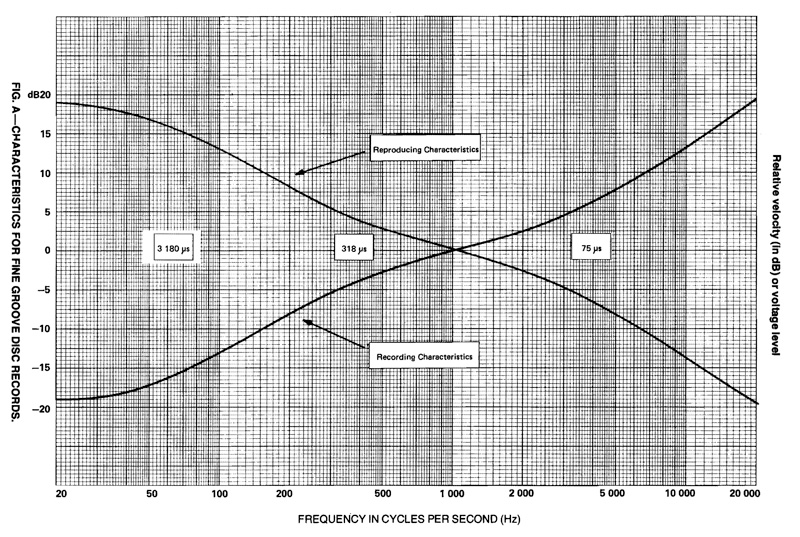
source: “RIAA Dimensional Standards: Bulletin No. E 1: Standard Recording and Reproducing Characteristics”
1954年1月29日に策定された、RIAA標準録音再生規格文書(の1978年11月6日改訂版)に掲載された、RIAA録音再生カーブのグラフ
RIAA Recording / Reproducing Curves, from the version revised on Nov. 6, 1978.
毎回書いている通り、筆者自身の学習過程を記したものですので、間違いの指摘や異論は遠慮なくお寄せください。
As I noted in every part of my article, this is a series of the footsteps of my own learning process, so please let me know if you find any mistakes on my article(s) / if you have different opinions.
いつものように長くなってしまいましたので、さきに要約を掲載します。同じ内容は最後の まとめ にも掲載しています。
Again, this article become very lengthy — so here is the summary of this article beforehand (the same summary are avilable also in the the summary subsection).
1950年代前半から、フィードバックカッターヘッドが民生用レコードのカッティングで使用されるようになり、カッターヘッド自体がほぼフラット記録特性を獲得した。
From the early 1950s, feedback cutterheads began to be used in cutting consumer records,and the cutterheads themselves acquired nearly flat recording characteristics.
それにより、かつてはカッターヘッドの特性と録音EQの合計で録音カーブを制御していたのに代わり、録音カーブ自体を録音EQ単体で実現可能になった。
This made it possible to realize the recording curve itself with the recording EQ alone, instead of controlling the recording curve with the sum of the cutterhead’s characteristics and the recording EQ.
1953年6月19日に承認された、放送局向けの NARTB Recording and Reproducing Standards は、1942年版および1949年版NAB規格を置き換えるもので、マイクログルーヴ盤や45回転盤も規格に明記された。また、高域プリエンファシスが強すぎると批判にさらされてきた録音カーブは、RCA Victor New Orthophonic 準拠のものに改訂された。
The NARTB Recording and Reproducing Standards for broadcasters, approved on June 19, 1953, replaced the 1942 and 1949 NAB Standards. Microgroove and 45 rpm records were also specified in the standards. The recording curve, which had been criticized for having too much high-frequency pre-emphasis, were revised to conform to the RCA Victor New Orthophonic characteristics.
オーディオ工学の学会 AES が1953年12月21日に暫定提唱規格として承認し、論文誌上で公開した Standard Playback Characteristic for Lateral Disc Recordings は、1951年に AES が発表していた標準再生カーブの改訂版であった。1953 NARTB すなわち New Orthophonic カーブに完全に対応する再生特性となっていた。1954年6月15日に正式に承認され、AES: TSA-1-1954 という文書となった。
The tentative draft of the Standard Playback Characteristic for Lateral Disc Recordings, approved on December 21, 1953 then published in the Journal of the Audio Engineering Society, was a revision of the AES Standard Playback CUrve published in 1951. This reproducing characteristics were fully compatible with the 1953 NARTB (thus New Orthophonic) curve. It was officially approved on June 15, 1954 and became the document AES: TSA-1-1954.
米レコード業界団体RIAAの主導で、RIAA Standard Recording and Reproducing Characteristic は、1954年1月29日に正式承認された。のちに RIAA Bulletin E1 という名称が与えられた。これも録音特性は 1953 NARTB すなわち New Orthophonic カーブと完全に同一のものであった。策定したのは、レコード業界内の緊密な技術協力体制を確立するために設立され、当時の業界を代表するエンジニア達で構成された、RIAA 技術委員会であった。
The RIAA Standard Recording and Reproducing Characteristic, developed by leading engineers at the time under the direction of the RIAA, the U.S. recording industry association, was officially approved on January 29, 1954. It was later given the name RIAA Bulletin E1. It was also completely identical in recording characteristics to the 1953 NARTB, i.e. New Orthophonic curve. It was formulated by the RIAA Engineering Committe, which was formed because the industry needed the closer cooperation in the record industry.
それまでの録音再生カーブは、グラフプロットのみの提示であることが多かったが、この3規格においては、カーブの定義が電気回路のアドミタンスやインピーダンスを使った数学的な表記で行われた。そこで重要になるのが「時定数」である。
Until these three curves appeared, recording and reproducing curves were often presented only as graph plots. But in these three standards, the curves were defined in methematical terms, using the admittance and impedance of electric circuits. “Time constant” is therefore important.
放送局業界である NAB、オーディオ工学の学会である AES、米レコード製造元らの業界団体である RIAA、これらの団体は、所属メンバも重複していたのはもちろん、互いに連携しあい、標準化を目指していた。
NAB being a broadcasting industry organization; AES being an audio engineering society; RIAA being a trade association of U.S. record manufacturers. These three organizations not only had overlapping memberships, but also collaborated with each other in their efforts to standardize the industry.
Contents / 目次
- 18.1 The Advent of Feedback Cutters
- 18.1.1 Feedback Cutters and “FLAT” Response
- 18.1.2 1938: Bell Labs / Western Electric’s Motional Feedback Vertical Cutter System
- 18.1.3 1941: Arthur Haddy’s Motional Feedback Lateral Cutter System of UK Decca
- 18.1.4 1949: Bell Labs / Western Electric’s “Westrex 2A” Motional Feedback Lateral Cutter System
- 18.1.5 1953: Grampian/BBC Type B1/AGU Non-motional Negative Veedback Lateral Cutter System
- 18.2 Before We Proceed: Three Disk Standards in 1953-1954
- 18.3 1953 NARTB Standards
- 18.3.1 RECORDING CHANGE REQUEST EXPECTED (Broadcasting Telecasting, April 6, 1953)
- 18.3.2 NARTB Committee Approves Recording Standard Changes (Broadcasting Telecasting, May 4, 1953)
- 18.3.3 NARTB Recording and Reproducing Standards (June, 1953)
- 18.3.4 NARTB Vol. Guide To Disk Standards (The Billboard, September 19, 1953)
- 18.4 1954 AES Standard Playback Curve
- 18.4.1 New Recording Characteristic (Audio Engineering, July 1953)
- 18.4.2 Standard Playback Characteristic for Lateral Disk Recordings (TS-1) (Journal of the Audio Engineering Society, January 1954)
- 18.4.3 Letters to the Editor: Disk Standard Comment (Journal of the Audio Engineering Society, April 1954)
- 18.4.4 AES Disk Standard Approved (Journal of the Audio Engineering Society, October 1954)
- 18.5 1954 RIAA Standard Recording and Reproducing Characteristic
- 18.5.1 Press for Full Membership in RIAA, Disk Org (The Billboard, November 17, 1951)
- 18.5.2 Disk Industry Assn. Rapidly Becoming Set (The Billboard, December 8, 1951)
- 18.5.3 First Board Meet Held by Disk Org (The Billboard, December 22, 1951)
- 18.5.4 John Griffin Named Exec Head of RIAA (The Billboard, February 23, 1952)
- 18.5.5 Formation of the RIAA Engineering Committee (1953)
- 18.5.6 RIAA Standard Recording and Reproducing Characteristic (Bulletin E1)
- 18.6 Example of RIAA Recording / Reproducing Equalizers at Studio
- 18.7 The summary of what I got this time / 自分なりのまとめ
18.1 The Advent of Feedback Cutters
1953年〜1954年に立て続けに策定された、ディスク録音再生新規格の話に入る前に、別のトピックをひとつ。
Before we dive into the history of the formation of three disk recording/reproducing standards in 1953-1954, here’s another topic.
1948年6月発表のLP盤(Pt. 11 参照)、1949年1月発表の45回転盤(Pt. 13 参照)、この2種類のマイクログルーヴ盤が誕生したころ、記録品質の更なる向上に貢献した重要な技術の1つが、ホットスタイラス 技術(Pt. 12 セクション 12.2 参照)でした。静粛なカッティングと高周波帯域の記録を両立し、線速度が落ちる内径でも十分なカッティングが行えるようになりました。
Around when the two microgroove formats — LPs in June 1948 (see: Pt. 11), and 45 rpms in January 1949 (see: Pt. 13) — were introduced, one of the technological innovations was Hot Stylus technique (see: Pt.12 Section 12.2), which enabled quieter cutting as well as better high-frequency recording with lower linear velocity, without using the diameter equalizer.
そして、LP 黎明期〜発展期に、ディスク録音技術においてもうひとつの大きな変化がありました。それは、フィードバックカッター の導入です。
Another innovation in these years was, the advent of Feedback Cutters.
フィードバック技術がカッターヘッドに使用されることにより、およそ1kHz前後に共振周波数を持つ単一共振系であるカッターヘッドに、「ほぼ」平坦な記録特性を持たせることが可能になりました。
The use of feedback technology into the recording systems made it possible to provide “nearly” flat recording characteristic for cutterheads, which naturally are single resonance systems with resonance frequencies around 1 kHz.
18.1.1 Feedback Cutters and “FLAT” Response
電気録音最初期は、メカニカルダンピングなどによるカッターヘッドの物理的な裸記録特性でのみカーブを制御していました(Pt.2 セクション 1.2.1 参照)。しばらくすると、さらに必要に応じて、狙ったターンオーバー周波数特性(電気録音最初期は 250N-FLAT 〜 300N-FLAT、のちに 500N-FLAT など)にする補正回路を足すことで、カーブを制御するようになりました。
Traditionally, cutterheads used for electrical disc recording had uncorrected electromechanical characteristics (250N-FLAT to 300N-FLAT in very early years) (see: Pt.2 Section 1.2.1) Later on, the desired recording curve (such as 500N-FLAT) was accomplished by using additional circuits to compensate the cutterhead’s raw characteristic.
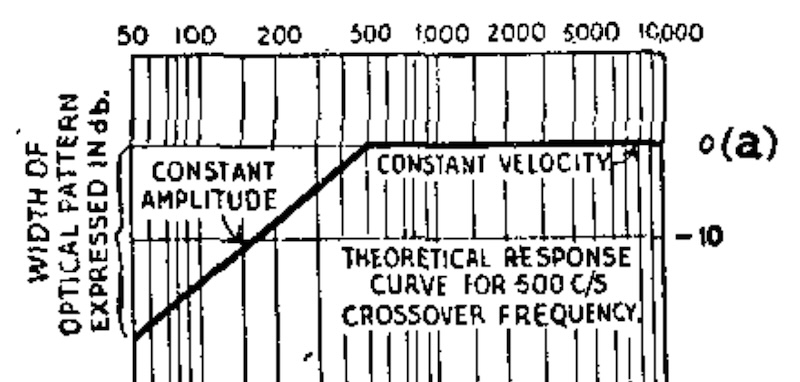
source: “Manual of Direct Disc Recording”, p.18, Bernards (Publishers), Ltd., 1944.
Pt. 10 セクション 10.1 のコラム でも紹介した、1943年に英国で発行された小冊子より。当時の電気録音における「フラット」とは、ターンオーバー周波数より下が constant amplitude で、それ以上は constant velocity で記録、高域プリエンファシスはなし、というものだった。
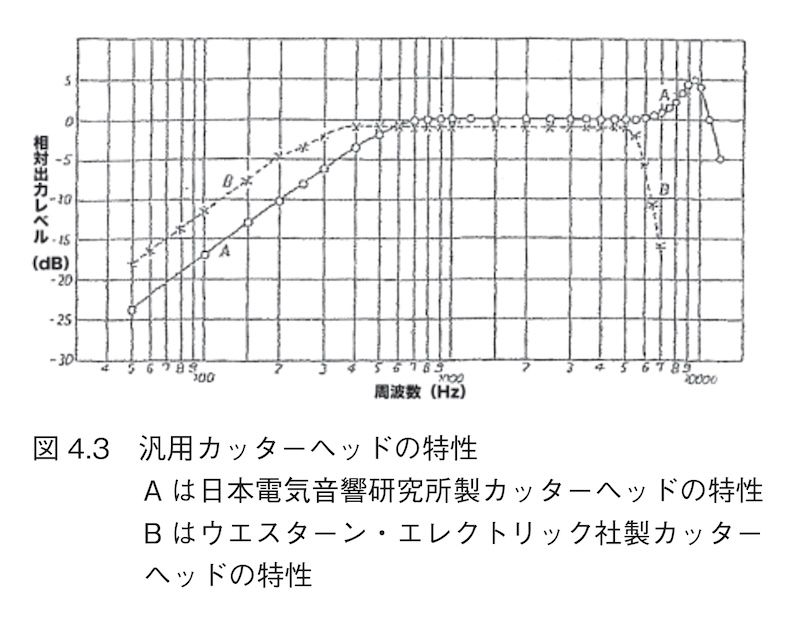
source: “アナログディスクレコード技術の系統化報告と現存資料の状況”, 穴澤健明, 国立科学博物館技術の系統化調査報告 Vol.21 2014. March, p.11
A: 日本電気音響研究所(のちの DENON) の坪田耕一氏開発のカッターヘッド (1939) の記録特性
B: Western Electric (恐らくラバーライン) カッターの記録特性
A: Frequency characteristic of Nippon Denki Onkyo Lab (pre-“DENON”)’s “Tsubota” cutterhead (1939)
B: Frequency characteristic of Western Electric’s (arguably “rubber-line”) recorder
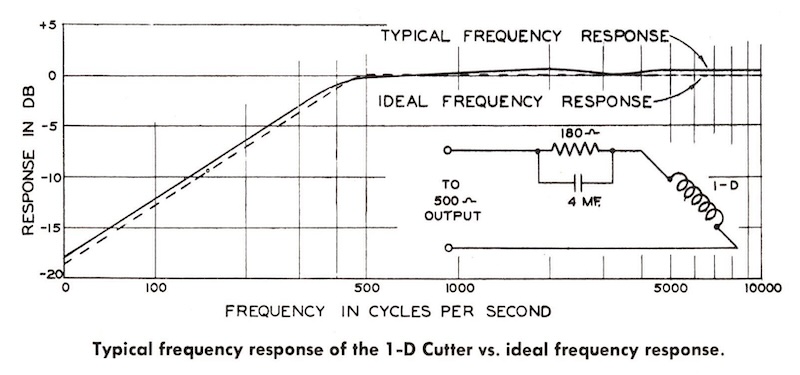
source: “PRESTO Instantaneous Sound Recording Equipment and Discs”, p.19, 1948, Presto Recording Corp. (from steampoweredradio.com)
Presto 1-D カッターヘッドの裸特性に並列RC補正回路を足して、ほぼ 500N-FLAT 特性を実現する例
その上で、さらに狙った録音EQカーブになるようにする補正回路を使用する、という組み合わせで、録音EQカーブを制御していました。
Then additional compensation circuits were applied to obtain the desired recording characteristic.
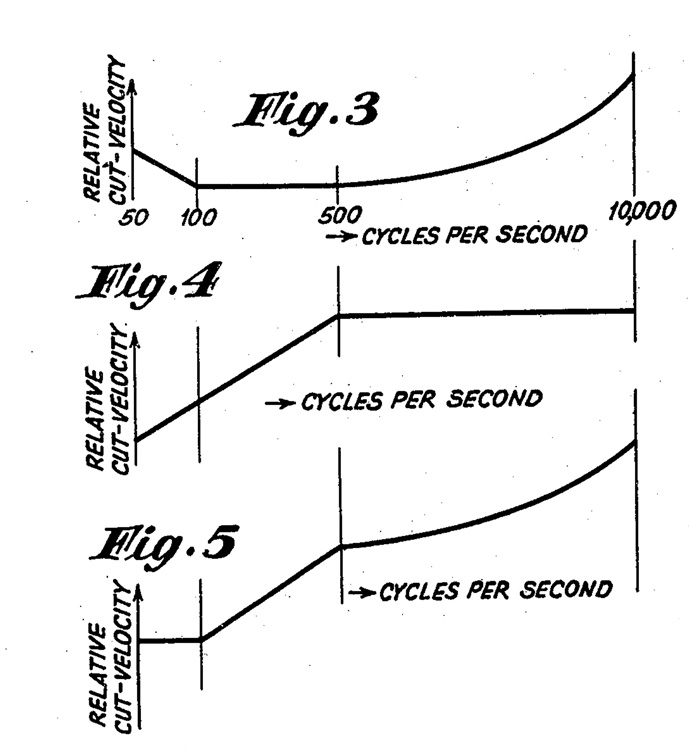
source: “Sound Translating System”, US Patent 2,286,494, Roland A. Lynn & Jarrett L. Hathaway, 1940
Pt. 5 で紹介した、Orthacoustic の特許文書より
Fig.4 がカッターヘッドの電気機械的記録特性(追加で補正回路を使う場合もあり)、
Fig.3 が Orthacoustic プリエンファシスフィルタ(録音イコライザ)特性、
Fig.5 が両者を合計した最終的な記録特性
Fig.4: Cutterhead’s Frequency Response (sometimes accomplished with additional circuits)
Fig.3: Frequency Response of the Orthacoustic pre-emphasis (recording) filter
Fig.5: Final recording characteristics of Orthacoustic, a combination of Fig.4 and Fig.3
Orthacoustic や 1942/1949 NAB のように、ターンオーバー周波数 500Hz、高域プリエンファシス +16dB at 10,000Hz、重低域ターンオーバー 100Hz の録音カーブを実現する際は、まずカッターヘッドの特性を 500N-FLAT (500Hz 以下は定振幅、500Hz 以上は定速度)に調整して、そこに狙った録音カーブになるよう、補正回路を追加していたのです。つまり、結果として得られる録音カーブは、カッターヘッドの特性と補正回路の合計によって実現されていました。
So, in order to obtain such recording characteristic as Orthacoustic and 1942/1949 NAB (with turnover frequency at 500Hz, high-frequency pre-emphasis of +16dB at 10,000Hz, and low-bass turnover at 100Hz), the first thing to be done was to fine-tune the cutterhead’s response characteristic to 500N-FLAT (constant amplitude below 500Hz, constant velocity above 500Hz); then additional equalizers were used to accomplish the desired recording characteristic as a whole.
それが、フィードバック技術導入後、カッターヘッド単体で(場合によってはさらに補正装置を追加して)定速度的に「ほぼ」フラットな記録特性に近づけ、その上で狙った録音EQカーブになるようにする補正回路を加えることで、録音特性を制御するようになりました。
However, after the advent of feedback cutters, cutterhead’s response characteristic (with feedback) was nearly flat in all frequency range (although in some cases additional compensation circuits were applied to accomplish flat response), then the recording EQ circuits were used.
言い換えると、カッターヘッドの特性(ターンオーバー)と、補正回路(重低域ターンオーバーと高域プリエンファシス)との組み合わせで総合的に実現されていた録音EQカーブが、フィードバック技術が導入された頃から、独立した録音EQ回路のみで実現されるようになっていったのです。
In other words, the recording EQ curve, which had been comprehensively realized by combining the characteristics of the cutterhead (turnover) and the compensation circuits (low-bass turnover and high-frequency pre-emphasis), began to be realized by independent recording EQ circuits alone when feedback technology was introduced.
この変化は、カッターヘッドの「フラット」の位置付けが代わった、と捉えることもできます。
This change can also be seen as a shift in the meaning of the “FLAT” of the cutterheads.
18.1.2 1938: Bell Labs / Western Electric’s Motional Feedback Vertical Cutter System
史上初めて、カッターヘッドにモーショナルフィードバックが適用されたのは、1938年、Bell Labs / Western Electric の縦振動トランスクリプション盤録音用でした(Pt. 4 セクション 4.4.2 参照)。
The first time ever that motional feedback was applied to cutterheads was in 1938, for Bell Labs / Western Electric’s vertical transcription recordings (see: Pt.4 Section 4.4.2).
ベル研の Leonard Vieth と Charles F. Wiebusch の両者が執筆した論文 “Recent Deveopment in Hill and Dale Recorders” が、SMPE 論文誌1938年1月号に掲載されました。
The paper “Recent Deveopment in Hill and Dale Recorders”, authored by Leonard Vieth and Charles F. Wiebusch of Bell Labs, was published in the January 1938 issue of the Journal of the SMPE (Society of Motion Picture Engineers).
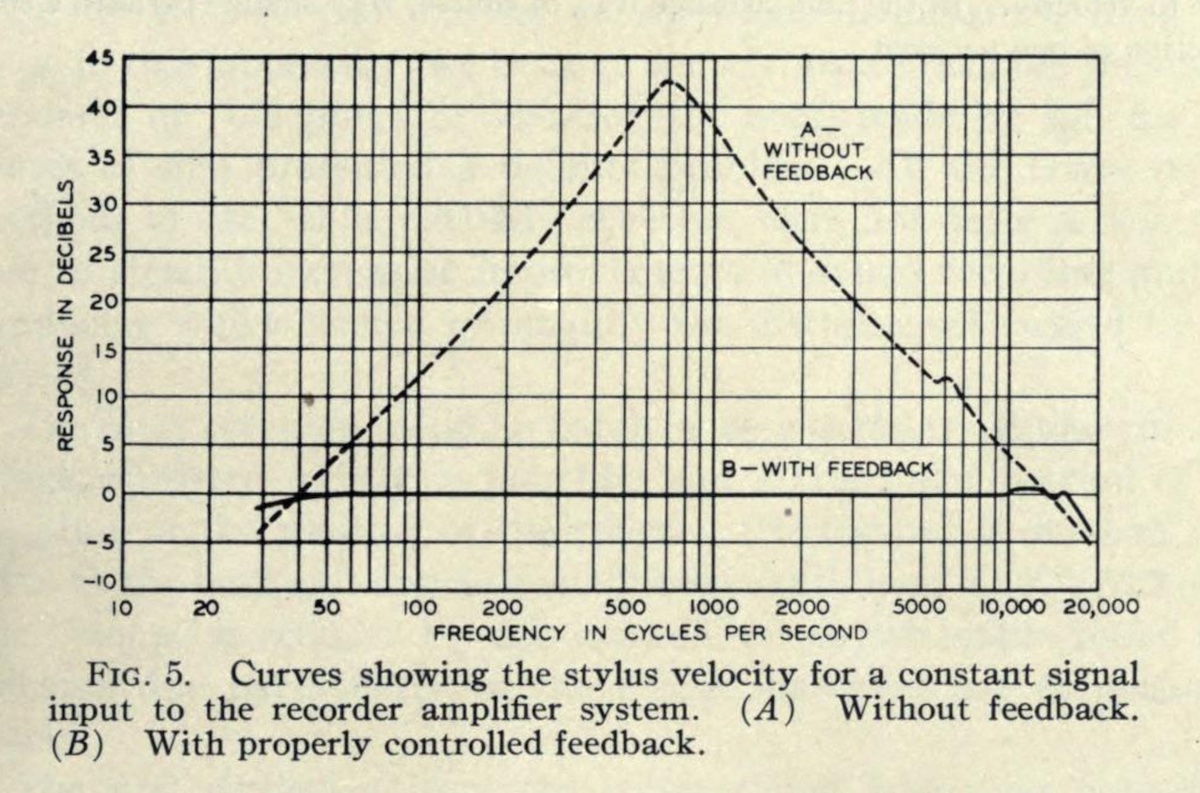
source: “Recent Development in Hill and Dale Recorders”, L. Vieth and C.F. Wiebusch, Journal of the Society of Motion Picture Engineers, January 1938, p.103.
1938年の JSMPE 論文より。フィードバック回路が備わった縦振動カッターヘッドで、フラットな周波数特性での記録が可能に
With the recorder properly wired into the system the technic of recording is exactly the same as with non-feedback recording systems. Inasmuch as the feedback system provides a flat response, any desired alteration of the response characteristic may be accomplished by means of electrical equalizers either ahead of the feedback system or in the feedback control circuit.
(今回開発した、縦振動用フィードバック)レコーダがシステムに適切に接続されていれば、録音技術はノンフィードバックシステムの場合と全く同じである。フィードバックシステムがフラットレスポンスを提供することにより、所望の応答特性への変更は、フィードバックシステムの前方、またはフィードバック制御回路内の電気イコライザによって達成することができる。
Recent Development in Hill and Dale Recorders, , L. Vieth and C.F. Wiebusch, Journal of the Society of Motion Picture Engineers, January 1938, p.10118.1.3 1941: Arthur Haddy’s Motional Feedback Lateral Cutter System of UK Decca
このモーショナルフィードバックの技術が、初めて横振動盤カッティングに応用されたのは 1941年、英国 Decca のエンジニア Arthur Haddy 氏 (1906-1989) が開発したカッターヘッドで、1944年に完成した Decca ffrr (Full Frequency Range Recording) システムで使われました。
The first application of the motional feedback technology to the lateral disc recorders was accomplished by UK Decca’s engineer Arthur Haddy (1906-1989). His motional feedback lateral cutter system was eventually used in the Decca ffrr (Full Frequency Range Recording) system, unveiled in 1944.
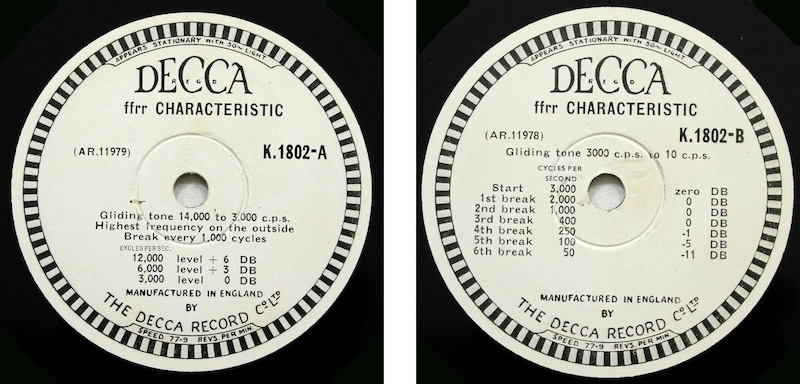
“Decca ffrr Characteristic” (Decca K.1802) (from Discogs entry).
Decca ffrr 特性テストレコード。
「77.9回転」(SPEED 77.9 REVS. PER MIN.) と書かれているのが興味深い。
残念ながら、当時の英 Decca における技術開発は秘密裏に行われたようで、それを伝える当時の雑誌記事もありませんし、当時の技術資料も公になっていないようです。
Unfortunately, it seems that the technical development at UK Decca at that time was conducted behind the closed doors, and there are no magazine articles from that time to report on it, nor are any technical documentation publicly available.
興味深い補足資料として、AES の学会誌 Journal of the Audio Engineering Society 1971年1月号 に掲載された “Haddy Addresses the 39th” があります。これは、1970年10月に開催された、第39回AESコンヴェンションにおいて、エミール・ベルリナー賞を受賞した Haddy 氏が行ったスピーチの書き起こしです。
An interesting supplement to Arthur Huddy’s cutterheads is “Haddy Addresses the 39th”, which appeared in the January 1971 issue of the Journal of the AES. This is a transcript of a speech given by Mr. Haddy at the 39th AES Convention in October 1970, where he received the Emil Berliner Award.
18.1.4 1949: Bell Labs / Western Electric’s “Westrex 2A” Motional Feedback Lateral Cutter System
一方、米国 で横振動盤向けモーショナルフィードバックカッターヘッドが登場したのは 1949年、Bell Labs / Western Electric の Westrex 2A カッターヘッドでした。Audio Engineering 誌 1949年9月号、AES 学会セクションに、この Westrex 2A カッターヘッドの原理を解説する論文「Lateral Feedback Disc Recorder」が掲載されています。
The first motional feedback cutterhead for lateral disc recordings, Westrex 2A from Bell Labs / Western Electric, appeared in the U.S.. The article, “Lateral Feedback Disc Recorder”, which appeared in the AES section of the Audio Engineering Magazine Sep. 1949, describes the principle of the Westrex 2A cutterhead.
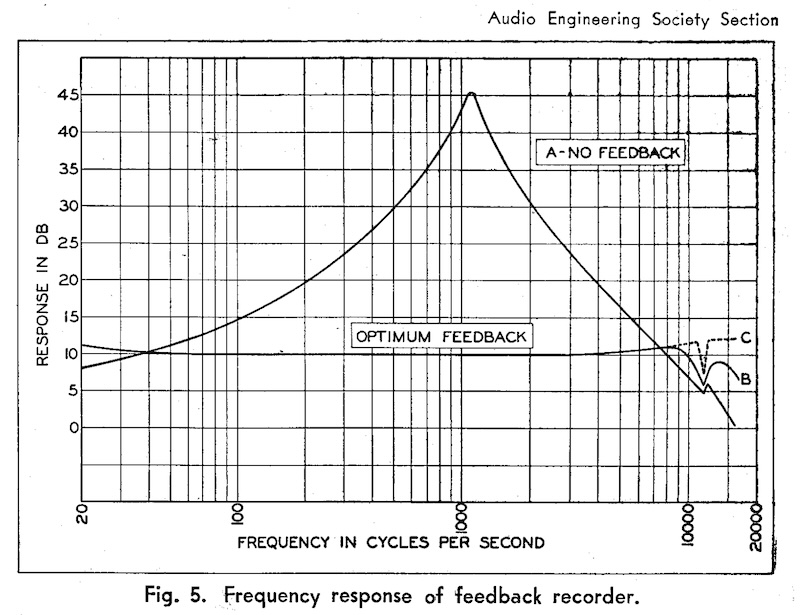
source: “Lateral Feedback Disc Recorder”, G.R. Yenzer. Audio Engineering Society Section, Audio Engineering, September 1949, p.25.
Westrex 2A フィードバックカッターの技術解説論文より、フィードバックなしの裸特性と、フィードバックありの特性のグラフ。
1954年には、改良型の Westrex 2B カッターヘッドが登場、AES 学会誌 (Journal of the Audio Engineering Society) 1954年10月号に解説論文「A Moving-Coil Feedback Disk Recorder」が掲載されました。
Then in 1954, an improved Westrex 2B was introduced, and a commentary article “A Moving-Coil Feedback Disk Recorder” appeared in the October 1954 issue of the Journal of the AES.
Since disk recording is primarily a constant-velocity type of recording wherein amplitude is inversely proportional to frequency, it is desirable to design a recorder for constant-velocity operation over the desired audio spectrum. With this done, electrical pre-equalization may be added in a straightforward manner to conform to any desired recording characteristic.
ディスク録音は本来定速度記録であり、振幅は周波数に反比例するため、所望の音声スペクトルに渡って定速度で動作するレコーダを設計することが望ましい。このようにすれば、電気的なプリイコライゼーションを直接的に追加することで、任意の所望の録音特性に適合させることが可能となる。
A Moving-Coil Feedback Disk Recorder, C.C. Davis, Journal of the Audio Engineering Society, Vol. 2, No. 4, Oct. 1954, p.229.18.1.5 1953: Grampian/BBC Type B1/AGU Non-motional Negative Veedback Lateral Cutter System
また、ノンモーショナルながらネガティブフィードバックを備えた BBC Type B カッターヘッドの商用版である Grampian/BBC Type B1/AGU カッターヘッドが 1953年に登場、米国スタジオでは1950年代半ばから使用されるようになりました。
The Grampian/BBC Type B1/AGU cutterhead, a commercial version of the BBC Type B cutterhead with non-motional negative feedback, was introduced in 1953, and began to be used in U.S. studios in the mid-1950s.
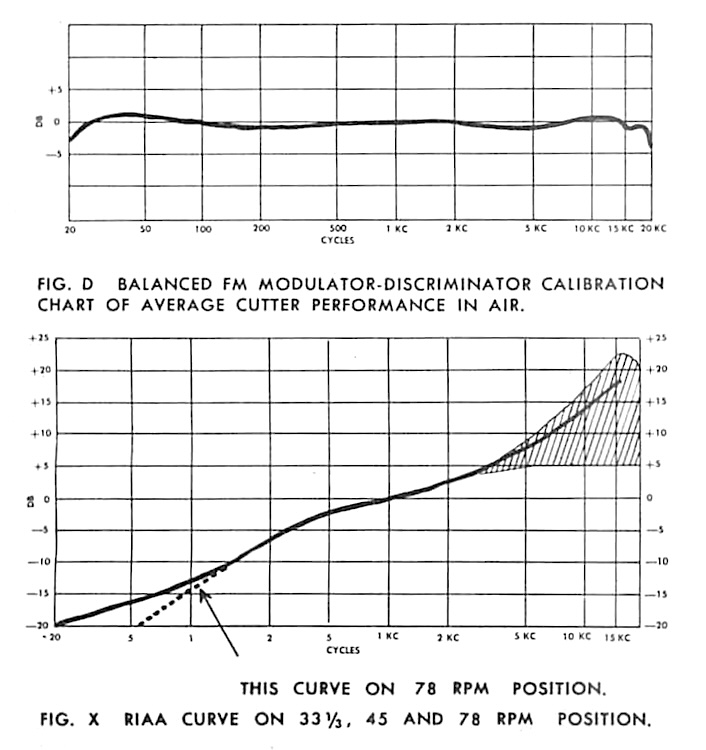
source: “Grampian / Gotham Feedback Cutter System” brochure (possibly mid-late 1950s), by Reeves Equipment Corp.
1950年代の Grampian / Gotham フィードバックカッターシステムの小冊子より。
Grampian / BBC ノンモーショナルネガティブフィードバックにより、Type B1/AGU カッターヘッド単体でのフラット特性を確保、
その上で Gotham PFB-150WA カッティングパワーアンプ内の RIAA 録音イコライザを適用する、というソリューション。
この Grampian / BBC B1/AGU カッターヘッドは、マスタリング専門の Mercury Sound Studios で使われたほか、1955年より Rudy Van Gelder が使用していたことでも知られています。
It is well known that this Grampian/BBC B1/AGU cutterhead was used at Mercury Sound Studios (mastering-only studios). Also, Rudy Van Gelder had used it since 1955.
また、Van Gelder 氏が、Grampian RA4 カッティングアンプより優れたダイナミックレンジが得られるシステムの開発を Gotham Audio 社に依頼し、その結果生まれたのが Gotham PFB-150WA カッティングアンプであったとのことです(参考: RVG Legacy)。
Around that time, Mr. Van Gelder “went to Gotham Audio and requested they develop a more powerful cutting amplifier for his Grampian cutterhead, an amp that would allow Van Gelder to cut masters louder and with greater dynamics. The result was the Grampian-Gotham Feedback Cutter System, which included the 150-watt Gotham Audio PFB-150 WA cutting amp” (quoted from RVG Legacy).
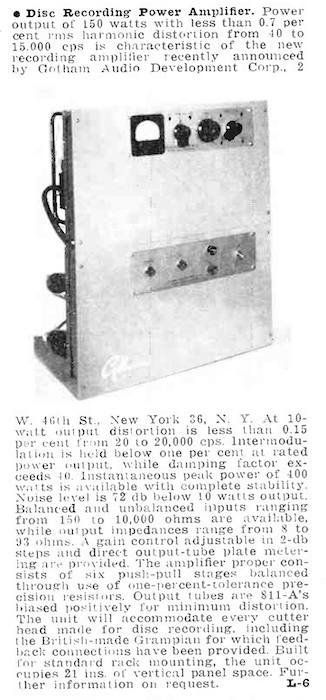
source: “NEW PRODUCTS”, Audio, Vol.39, No.7, July 1955, p.34.
Audio誌1955年7月号の新製品コーナーで紹介されている Gotham PFB-150WA
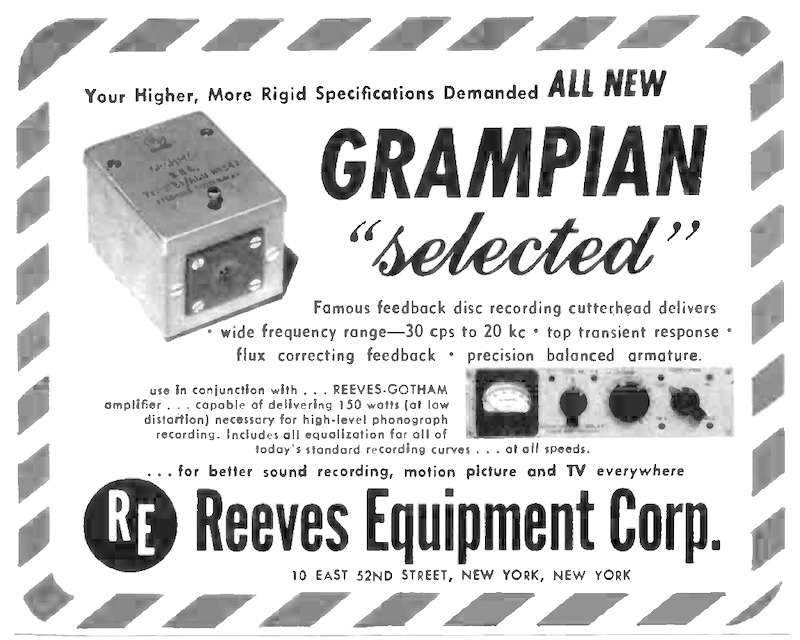
source: Reeves Equipment Corp. Ad. Audio, Vol.39, No.1, January 1955, p.76.
Audio 誌 1955年1月号に掲載された、PFB-150WA と思われるアンプのクローズアップ。
この広告では「REEVES-GOTHAM amplifier」とだけ記載。
The Ad of Grampian feedback cutterhead, and (possibly the closeup of) PFB-150WA,
simply noted as “REEVES-GOTHAM amplifier” here.
このように、米国のレーベルやスタジオにフィードバックカッターが普及していくタイミングと、録音再生標準規格が策定されるタイミングが、ほぼ同時期であること、これも非常に興味深いです。
It is also very interesting to note that the timing of the spread of feedback cutters among U.S. labels and studios and the timing of the development of recording / reproducing standards are roughly contemporaneous.
18.2 Before We Proceed: Three Disk Standards in 1953-1954
ここで、過去にも学び、そして今回新たに登場する、3つのディスク録音・再生規格、これらの立ち位置を整理しておきましょう。
Here is the summary of the three Disc Recording / Reproducing Standards we are going to learn / we have learned in the past articles.
まだ民生用レコードはシェラック製78回転盤しかなかった頃、すでにヴィニライト製16インチ33 1/3回転のトランスクリプション盤を使っていたラジオ業界内の標準規格として1942年に生まれた、NAB 録音再生標準規格。
The NAB Recording and Reproducing Standards, initially formulated in 1942, as a standard within the radio industry, which was already using vinylite 16-inch 33 1/3 rpm transcription discs (while only shellac 78 rpms were still used for consumer releases).
NAB/NARTB 録音再生標準規格 (NAB/NARTB Recording and Reproducing Standards) は、1923年に設立された業界団体 NAB (the National Association of Broadcasters, 全米放送事業者協会) が、米国放送局業界向けに策定した標準規格。NAB は、1951年〜1958年のみ NARTB = the National Association of Radio and Television Broadcasters (全米ラジオ・テレビ放送事業者協会) という名称であった。
NAB/NARTB Recording and Reproducing Standards was the standards of the broadcasting industry in the U.S., by the trade association named NAB (the National Association of Broadcasters). From 1951 to 1958, NAB changed its name to NARTB (the National Association of Radio and Television Broadcasters).
当規格の対象となるレコードは、放送局用にプレスされたヴィニライト製のトランスクリプション盤、および、通称「アセテート録音機」によって即時録音されたラッカー盤。民生用レコードは直接の対象ではない。
It included the standards for transcription records (vinylite press) as well as lacquer discs cut with “instantaenous recorders”. It was not for consumer records.
初版は1942年に発行された。その時の名称は「放送局用トランスクリプション盤用、およびラジオ放送における(即時)録音用の、技術的標準規格およびエンジニアリング実践規範」(“Technical Standards and Good Engineering Practices of The National Association of Broadcasters for Electrical Transcriptions and Recordings for Radio Broadcasting”) であった。
The initial version was published in 1942, under the title “Technical Standards and Good Engineering Practices of The National Association of Broadcasters for Electrical Transcriptions and Recordings for Radio Broadcasting”.
その後、1949年4月、1950年6月にそれぞれ改定版が発行された。1949年版からオープンリールテープの規格が追加された。
Revised and amended versions were published in April 1949 and June 1950. The 1949 NAB Standards included the standards for Reel-to-Reel tapes.
参考 / See Also: Pt.8 (1942 NAB Standards); Pt.10 (1949 NAB Standards).
1953年6月の改訂版では、ディスク録音再生特性が変更された。また、この1953年版からマイクログルーヴ(fine groove)盤および45回転盤が規格に入った。
The June 1953 revision included the change of disc recording / reproducing characteristics. The 1953 NARTB Standards included microgroove (fine groove) records and transcriptions, as well as 45 rpm records.
のちに録音再生規格はディスク用、カートリッジテープ用、オープンリールテープ用と分割され、ディスク用は1964年2月に発行された。
Later, the Recording and Reproducing Standards were broken into three areas: Disc; Cartridge Tape; and Magnetic Tape (Reel-to-Reel). The NAB Disc Standard was published in February 1964.
LPや45回転盤が市場に登場し、同時にハイファイブームが起こった1950年代初頭、多くの業界エンジニアが所属する学会 AES により、録音再生特性の乱立を収束させる目的で提唱された、AES 標準再生カーブ。
The AES Standard Playback Curve, initially proposed in the early 1950s, when LPs and 45 rpm records were becoming popular in the market, and the “Hi-Fi” were booming at the same time. It was proposed by the AES, an academic society (which many industry engineers belonged), with the aim of converging the disorder of recording and reproducing characteristics.
AES標準再生カーブ (AES Standard Playback Curve) は、全米初のオーディオ工学専門の学会、AES = Audio Engineering Society が 1951年に提唱した、レコード用標準再生規格 (AES-1951)。
AES Standard Playback Curve (AES-1951) was the reproducing standards that was formulated and proposed in 1951, by AES (Audio Engineering Society), America’s first academic society specialized in audio engineering.
民生用レコードを再生する、民生用オーディオ機器が対象。再生規格のみであり、録音規格は定義されていない。
It was the Standard Reproducing Curve for consumer audio equipments (thus for playing consumer disc records): recording curve was not specified.
録音カーブの統一をはかるのではなく、再生カーブを標準化することで「録音エンジニアには好きなカーブで録音してもらって良いが、この標準再生規格で適切なバランスで再生されるようにすること」を狙って策定された。
The plan was “to standardize on a playback curve and to let the recording engineers make their records however they see fit, knowing that they must sound properly balanced when played on this standard reproducing characteristics”.
また、当時市販されていた78回転盤、45回転盤、33 1/3回転盤で使われていた各種録音特性の「折衷案」としての側面ももち、どのレコードでもまずまずの再生が可能な単一再生カーブとして提唱された。
The AES Curve was also a compromise of various curves used for 78 rpms, 45 rpms and 33 1/3 rpms around that time. It was intended for decent playing various discs with a unified reproducing characteristic.
あくまで「提唱」であり、業界規格ではない。
It is not a industry standard, but a proposal.
参考 / See Also: Pt.16 (1951 AES Playback Standard Curve).
1953年12月21日に “Standard Playback Characteristic for Lateral Disk Recordings” というタイトルで改訂版ドラフト (TS-1) が出され、1954年6月15日に承認され正式版 (TSA-1-1954) となった。
The draft of the revised version (TS-1), with the title “Standard Playback Characteristic for Lateral Disk Recordings”, was proposed in December 21, 1953, then it became the final version (TSA-1-1954) which was approved on June 15, 1954.
レコード業界の主要エンジニアが協力し、レコード業界(レーベル)みずからが動くべく、業界標準の録音再生規格として策定した、RIAA 標準録音再生特性。
The RIAA Standard Recording and Reproducing Characteristic, established as an industry-standard characteristic by the engineers of the major labels at the time.
RIAA 標準録音再生特性 は、1952年に設立された米レコード業界団体 RIAA (Recording Industry Association of America) が、民生用レコード用に策定した標準規格。
RIAA Standard Recording and Reproducing Characteristic was the standard for consumer disc records, published by the trade association named RIAA (Recording Industry Association of America). The association was established in 1952.
放送局団体(NAB/NARTB)が策定した規格でも、音響エンジニアたちの学会(AES)が策定した提唱規格でもなく、レコード業界団体自体が規格を策定することで、業界内の連携を強めるために策定された。
It was NOT the standard of broadcasting industries (i.e. NAB/NARTB), NOR the standard by the academic society of audio engineers (i.e. AES), BUT a standard formulated by the association of the record industry, in order to strenghen collaboration within the industry.
策定は RIAA 技術委員会 (The Engineering Committee of the RIAA) メンバによって行われ、1954年2月に初版 (RIAA Bulletin E1) が承認された。
The Standard was formulated by the members of the Engineering Committee of the RIAA, and approved the initial version (RIAA Bulletin E1) in February 1954.
マイクログルーヴ(fine groove)盤のみが対象で、ワイドグルーヴ(coarse groove) 盤は対象外とされた。
The RIAA Standard was only for microgroove (fine groove) records: widegroove (coarse groove) records was not considered.
この3つの規格が生まれた1942年から1954年の間、特に1940年代後半から1950年代前半の5年間には、ディスク録音再生において、多くの技術革新が生まれ、導入されていきました。
Between 1942 and 1954, when these three standards were formulated, and especially during the five years from the late 1940s to the early 1950s, many technological innovations in disk recording and playback were developed and introduced.
かようにレコードの歴史は技術革新の歴史であり、そして規格の標準化を目指した歴史でもありました。
History of the record is, therefore, the history of technological innovation and standardization as well.
18.3 1953 NARTB Standards
1939年に RCA/NBC がトランスクリプション盤向けに開発した Orthacoustic 特性 (Pt. 5 セクション 5.2.1〜5.2.3 参照)が、1942年にラジオ業界内向け NAB標準規格 の録音特性として採用されました(Pt. 8 参照)。
The Orthacoustic characteristic (see: Pt.5 Section 5.2.1 to 5.2.3), developed by RCA/NBC in 1939 for transcription discs, were adopted as the recording characteristic of the NAB Standards for the radio industry in 1942 (see: Pt.8).
当時の盤はまだマイクログルーヴではなく、カッティング技術も発展途上で、内周に向かうほど高域減衰が発生する問題がありました。また、当時の最高技術をもってしても 10,000Hz 付近が実質的な記録上限でした。
At that time, discs were not “micro-groove” but “coarse groove”; and cutting technology was still developing. There was a recording problem of high-frequency attenuation toward the inner circumference area. Even with the best technology of the time, the upper limit of disc recording was around 10,000Hz.
これを補うために、Orthacoustic 〜 1942 NAB 〜 1949 NAB における高域プリエンファシスは +16dB at 10,000Hz(時定数 100μs)とされ、またカッティング時に内周に向かうほど高域増幅を強める「自動補正イコライザ」(Pt. 17 セクション 17.3.3 コラム 参照)が使われていました。
In order to compensate for the problem, the high-frequency pre-emphasis of Orthacoustic (and 1942/1949 NAB) curve was set at +16 dB at 10,000Hz (time constant: 100μs). Also, an “automatic diameter equalizer” (see: the column in Pt.17 Section 17.3.3) was used to increase high frequency toward the inner circumference area.
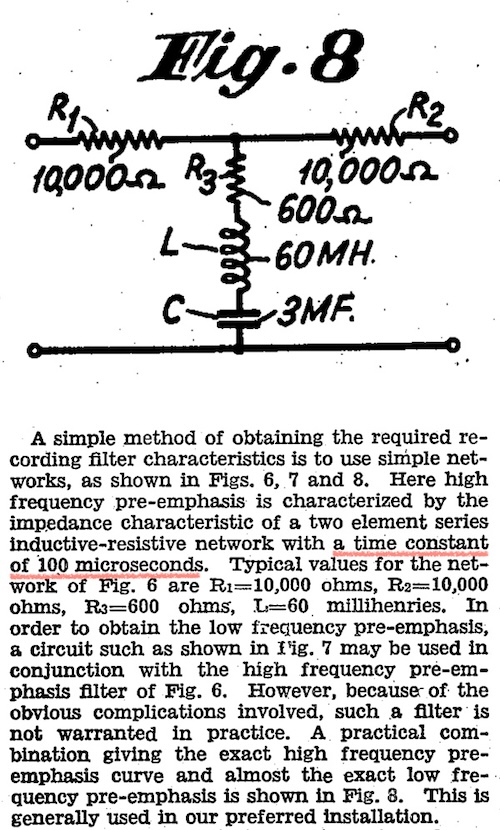
source: “Sound Translating System”, US Patent 2,286,494, Roland A. Lynn & Jarrett L. Hathaway, 1940
1940年の Orthacoustic 特許文書より、高域プリエンファシスと重低域ターンオーバーを実現する回路図と、100μsと言及している箇所
High-frequency pre-emphasis + low-bass turnover (“bass-shelf)” filter network, from the 1940 Orthacoustic patent, which mentions “time constant of 100 microseconds”
第二次大戦後の1947年に再開された NAB 標準規格委員会の会合ですでに、「100μsは強すぎ、せめて75μsに下げるべきである」、という意見が噴出していました(Pt. 10 参照)。ワイドグルーヴであった当時、強い高域プリエンファシスではトレーシング歪や高域歪が発生しやすいから、という理屈でした。しかし、その100μsプリエンファシスは1949年NAB標準規格でも引き継がれました。
At the NAB Standards Committee meeting resumed in 1947 after the World War II, many opinions had already erupted that “100μs was too strong; should be lowered to at least 75μs” (see: Pt.10). It gradually became clear that, in the “wide-groove” years, a strong high-frequency pre-emphasis would easily cause tracing distortion and high-frequency distortion. However, the 100μs pre-emphasis was carried over to the 1949 NAB Standards.
その後、民生用レコードで 1mil 針で再生するマイクログルーヴ盤が登場(Pt. 11 および Pt. 12 参照)、シェラック盤に比べて圧倒的に静粛なヴィニライト盤が民生用でも一般化します。さらに、ホットスタイラス技術の実用化(Pt. 12 セクション 12.2 参照)により、カッティング時に記録可能な周波数帯域が 15,000Hz 以上に伸び、同時に内周でも十分な高域記録が行えるようになりました。
Subsequently, microgroove records played with a 1-mil stylus appeared in the market (see: Pt. 11 and Pt. 12), and vinylite records, which were far quieter than shellac records, became common for consumer use as well. Furthermore, the aractical application of Hot Stylus technology (see: Pt.12 Section 12.2) extended the frequency bandwidth that could be cut to 15,000Hz or higher, and at the same time, it became possible to record sufficiently high frequency even in the inner circumference area.
これらの技術革新により、NAB カーブや Columbia LP カーブの 100μs という強すぎる高域プリエンファシスを弱めるべき、という意見が、ますます強くなっていきました。
These innovations led to a growing consensus that the 100μs high-frequency pre-emphasis of NAB curve and Columbia LP curve should be weakened.
NAB 標準規格委員会の会合の様子を伝えてきた NAB 総合機関誌「NAB Reports」は、1949年2月をもって休刊となり、翌月からは各部門ごとの「NAB Member Service」という機関誌が発行されました(Pt. 10 セクション 10.1.5 参照)。しかし、この「NAB/NARTB Member Service」は非公開であり、閲覧することができません。
“NAB Reports” was a general bulletin of NAB, and it continuously reported on the meetings of the NAB Standards Committee, until it ceased publication in February 1949. Then starting the following month, member service bulletins for each deparmtnent named “NAB Member Service” were published, whilst all department was restricted to share they might receive — which means, we are not allowed to browse and read them publicly.
そのため、残念ながら、1953 NARTB 規格の策定過程、すなわち 1949年4月〜1953年6月 の議論をひもとく資料は一般向けには入手できないことになります。
Therefore, unfortunately, primary source document that arguably trace the process of the formulation of the 1953 NARTB Standards, i.e. the discussions among NARTB Standards Committee members from April 1949 to June 1953, are not available to the public.
幸いなことに、「Broadcasting Telecasting」や「The Billboard」といった当時の業界誌のニュース記事に、一部その議論の痕跡を認めることができます。
Fortunately, some traces of the discussion can be found in news articles in trade journals of the time, such as “Broadcasting Telecasting” and “The Billboard”.
18.3.1 RECORDING CHANGE REQUEST EXPECTED (Broadcasting Telecasting, April 6, 1953)
Broadcasting Telecasting 誌 1953年4月6日号に「RECORDING CHANGE REQUEST EXPECTED」という記事が掲載されています。1953年4月28日に開催される、NARTB 録音再生標準化委員会の会合で、ディスク録音カーブの変更が行われる模様だ、と報告しています。
The April 6, 1953 issue of Broadcasting Telecasting magazine reports “RECORDING CHANGE REQUEST EXPECTED”, that “new recording standards … will be submitted to the Standards Committee at the April 28, 1953 meeting”.
NEW recording standards designed to bring technical elements of reproduction in line with progress in the art will be submitted to the NARTB Recording & Reproducing Standards Committee at a meeting set April 28 at the Hotel Biltmore, Los Angeles.
(1953年)4月28日、ロサンゼルスのホテル・ビルトモアで開催される NARTB 録音再生標準化委員会において、技術の進歩に沿った再生技術をもたらすよう設計された、新しい録音規格が提出される予定である。
Neal McNaughen, NARTB Engineering Dept. manager and chairman of the committee, will preside at the meeting, a convention week event.
NAB 技術部門のマネージャ、そして NARTB 録音再生標準化委員会の委員長を務める Neal McNaughen 氏が、この会合で議長を務める。
First change in NARTB recording curve in a decade will be proposed to the committee, whose extensive research before and during World War II brought uniformity out of chaos in the sound-reproduction process and in the equipment employed. A disc subcommittee headed by K.R. Smith, Allied Record Mfg. Co., will propose that the disc curve be changed from 100 to 75 microseconds (μs/s).
第二次世界大戦前から戦中にかけての広範な研究の結果、音響再生プロセスと使用機器の混沌を抜け(1942年NAB規格として)統一がもたらされたが、そのNARTB 録音カーブに10年ぶりの変更が提案される。Allied Record 社の K.R. Smith 氏を委員長とするディスク小委員会は、100μsから75μsに変更したカーブを提案することになっている。
This change, based on long subcommittee study, will reduce the pre-emphasis on higher frequencies. Originally this pronounced pre-emphasis was required to overcome noise in recording material. The new hot-stylus cutting of masters, improved vinyl products and smaller grooves permit less pre-emphasis without loss of quality. Listeners should notice no difference, it was explained, nor will present libraries be affected.
この変更は、ディスク小委員会の長期に渡る研究に基づくものであり、高域プリエンファシスを減らすものである。元来、この顕著なプリエンファシスは、ディスク素材のノイズ克服のために必要であった。しかし、新技術であるホット・スタイラスによるカッティングが行われるようになり、レコード素材の品質も向上し、より微細な音溝となったことで、音の品質を損なうことなくプリエンファシスの低減が可能となった。(録音再生カーブの変更後も)リスナーは違いを感じないはずであり、現在のライブラリにも影響はない、と説明されている。
NARTB plans to express the factor in mathematical terms instead of graph paper. This is expected to permit easier design of equalizers.
NARTB は、(新しい録音カーブを)方眼紙上のグラフとして提示する代わりに、数学用語で表現することを計画している。これにより、イコライザの設計が容易になると期待されている。
Included in the proposed new standard are 45 rpm recordings.
提出される新しい標準規格案には、45回転盤も含まれている。
The magnetic tape subcommittee, headed by W.E. Stewart, RCA, will recommend standards with a 50 μs/s pre-emphasis at 15 inches per second. This will remove one of the most serious problems in tape recording — lack of pre-emphasis uniformity between stations. It is expected to speed up development of tape libraries.
RCA 社の W.E. Stewart 氏が委員長を務める磁気テープ小委員会は、毎秒15インチで 50 μs/s のプリエンファシスとなる規格を推奨する予定である。これにより、テープ録音における最も深刻な問題のひとつである、放送局間でのプリエンファシスの不統一が解消されることになる。テープライブラリの開発が加速されると期待されている。
The committee has not yet taken up standards for magnetic tape TV recording, awaiting development of the art.
同委員会は、磁気テープによるTV録画の規格をまだ取り上げていないが、これは技術の発展を待つということである。
“RECORDING CHANGE REQUEST EXPECTED”, p.48, Broadcasting Telecasting, April 6, 1953.放送業界誌である Broadcasting Telecasting のこの記事において、「時定数」 (time constant) が登場しました。それまでは、技術論文と特許文書の中にのみ登場していました。一般向け雑誌における数少ない例は、Pt. 10 セクション 10.1.1 でも紹介した、Audio Engineering 1947年10月号における、NAB 規格委員会の模様を報告する記事でみることができます(Audio 誌に誌名変更する前の Audio Engineering 誌は、録音エンジニアや研究者向けのオーディオ工学専門雑誌という位置付けでしたが)。
The term “time constant” appeared in this article in Broadcasting Telecasting, a broadcast trade magazine. Until then, it appeared only in technical papers and patent documents. A rare example in a general engineering magazine can be found in the article reporting on the NAB Standards Committee meeting in the October 1947 issue of Audio Engineering magazine (see: Pt.10 Section 10.1.1), although the magazine was for recording engineers and researchers until it was renamed to Audio magazine.
それまでの NAB 規格の文書の中には、NAB 録音カーブの周波数特性グラフが提示されているだけでしたが、新規格では時定数も明示されることが伺え、プロットされたグラフからの推測で補正回路を設計するのではなく、電気回路の素養があるエンジニアであれば補正回路を制作できることになります。
The previous NAB Standards documents only presented a frequency response graph of the NAB recording curve, but it appears that the new standard will also clearly state the time constants, so that engineers can design and develop an appropriate compensation circuits with ease, rather than just guessing the circuit from a plotted graph.
18.3.2 NARTB Committee Approves Recording Standard Changes (Broadcasting Telecasting, May 4, 1953)
1953年5月4日号では、4月28日の録音再生標準化委員会の会合の結果、録音カーブ変更が無事承認され、あとは6月に NARTB 理事会の承認を待つのみとなった、と報告されています。
The May 4, 1953 issue reported that, as a result of the April 28 meeting of the Recording and Reproducing Standards Committee, the recording curve change was successfully apprved and now awaits NARTB board approval in June.
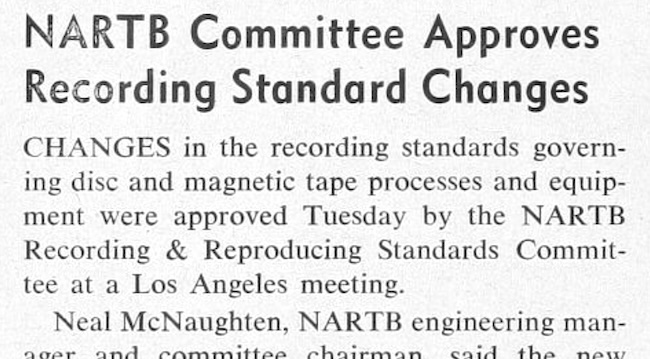
source: “NARTB Committee Approves Recording Standard Changes”, Broadcasting Telecasting, May 4, 1953, p.30.
CHANGES in the recording standards governing disc and magnetic tape process and equipment were approved Tuesday by the NARTB Recording & Reproducing Standards Committee at a Los Angeles meeting.
ロサンゼルスで開催された NARTB 録音再生標準化委員会において、ディスクと磁気テープによる録音プロセスおよび機器に関する、録音標準規格の変更が承認された。
Neal McNaughten, NARTB engineering manager and committee chairman, said the new standards provide additional specifications for tape along with a new recording curve. Some changes were made in disc standards and a new curve was approved.
NARTB 技術部門のマネージャ、兼、NARTB 録音再生標準化委員会の委員長である Neal McNaughten 氏によると、磁気テープの新しい録音カーブのほか、テープに関する追加仕様を規定している、とのことである。またディスク規格においてはいくつかの変更がなされ、新しいカーブも承認された。
The committee’s action was based on sub-committee studies made during the past year. Revised standards will be submitted to the NARTB board in June for final approval. They will become effective after board action.
当委員会の決定は、過去1年間に行われた小委員会の研究に基づいている。改定された標準規格は、6月に NARTB 理事会に提出され、最終承認を受ける。当規格は理事会の決定後に発効されることとなる。
NARTB and its predecessor, NAB, set the first recording standards early in the last decade. They have been generally followed in the U.S. and have been receiving acceptance in other countries. The uniformity in processing and in equipment is credited with providing a stabilizing influence in the recording industry and in the use of recording techniques by broadcasters and related groups.
NARTB とその前身である NAB は、1940年代初頭に初となる録音規格を策定した。この企画は米国ではおおむね踏襲されてきた他、他国でも受け入れられつつある。録音プロセスと機器の特性の統一は、録音業界、および放送局やその関連団体による録音技術の使用の上で、安定した影響を与えた、と評価されている。
New tape standards cover the reproducing head, tape wind and signal-to-noise ratio. The new tape reproducing characteristic curve is based on a speed of 15 inches per second.
新しいテープ規格は、再生ヘッド、テープの巻き取り方、S/N比をカバーしている。新しいテープ再生特性カーブは、15インチ/s の速度に基づいている。
The new later disc standard is controlled by a curve with pre-emphasis of 75 micro-seconds; middle low characteristic a 318 microsecond curve with crossover at at 500 cycles and the low frequency end 10 times the 318 microsecond curve or 3180 microseconds with a crossover at 50 cycles.
改訂版となる新しいディスク標準規格は、75μsのプリエンファシスによるカーブで制御される。中低域特性は 318μs のカーブで、クロスオーバー周波数は 500Hz である。重低域は 318μs の10倍、つまり 3,180μs のカーブで、クロスオーバー周波数は 50Hz となる。
“NARTB Committee Approves Recording Standard Changes”, p.30, Broadcasting Telecasting, May 4, 1953.この続報記事では、高域プリエンファシスの時定数 75μs のみならず、中域のターンオーバー周波数に関係する 318μs、そして重低域ターンオーバー(ベースシェルフ)に関係する 3,180μs、という、3つの時定数が全て紹介されています。
In this follow-up article, all three time constants are noted: not only the 75μs time constant for high-frequency pre-emphasis, but also the 318μs related to the mid-frequency turnover frequency, and the 3,180μs related to the low-bass turnover (aka bass shelf).
電気録音の歴史上、方眼紙にプロットした周波数特性グラフのみならず、その特性を実現する電気回路の時定数を明確に示したのは、1953年 NARTB カーブ、ということになるのでしょう。
So, in the history of electrical recording, it is probably the 1953 NARTB curve that clearly shows not only the frequency response graph plotted on a pice of graph paper, but also the time constants of the electrical circuit that achieve the desired response.
18.3.3 NARTB Recording and Reproducing Standards (June, 1953)
そして、1953年6月19日、NARTB 理事会に正式に承認されたのが、いわゆる 1953 NARTB 録音再生標準規格 です。
Then so-called “1953 NARTB Recording and Reproducing Standards” was officially approved by the NARTB Board of Directors on June 19, 1953.
前述の通り、NAB/NARTB 規格としては初めてマイクログルーヴ (fine groove) 盤も定義され、また回転数として(33 1/3回転と 78.26回転に加えて)45回転も追加されました。1942 NAB 規格から存在している、縦振動トランスクリプション盤向けの規格もまだ残っています。その他、追加項目がいくつか目につきますが、最も大きな変更はもちろん、録音特性すなわちEQカーブの変更です。
As mentioned above, the new Standards included microgroove (fine groove) discs for the first time, as well as 45 rpm discs (along with 33 1/3 rpm and 78.26 rpm). The standard for vertical transcription discs, which had existed since the 1942 NAB Standards, was still in place with no modification. There are several other additions that stand out, but the most significant change is, of course, the change in recording characteristics — the recording EQ curve.
標準規格内の文面は、1942 NAB(Pt.8 セクション 8.2)、1949 NAB(Pt.10 セクション 10.2)同様、非常にあっさりしたものです。
The text within the standards is very plain, as is in the 1942 NAB Standards (see: Pt.8 Section 8.2) and in the 1949 NAB Standards (see: Pt.10 Section 10.2).
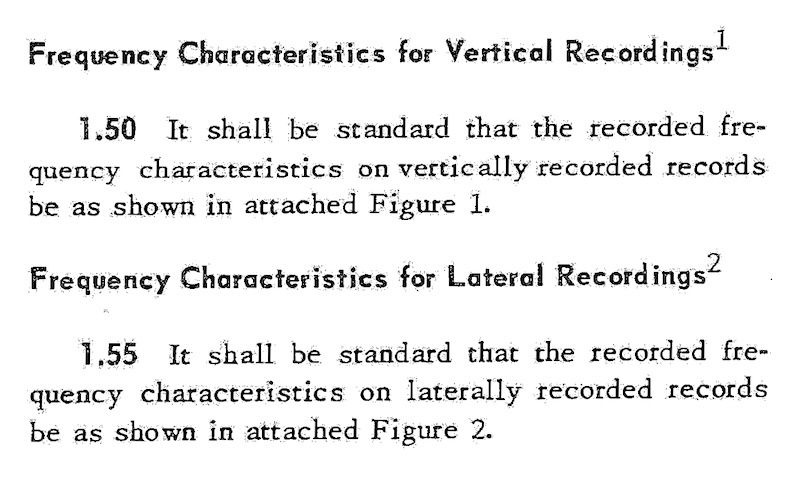
source: Supplement No.2 to NAB (NARTB) Engineering Handbook (Fourth edition, 1949): NARTB Recording and Reproducing Standards (June 1953), p.1-3-03.
1.50 では縦振動盤について、1.55 では横振動盤について、それぞれ「録音周波数特性は図の通りとする」とあるのみ。
しかし、脚注として、見逃せない記載があります。
However, there is a footnote that should not be overlooked.
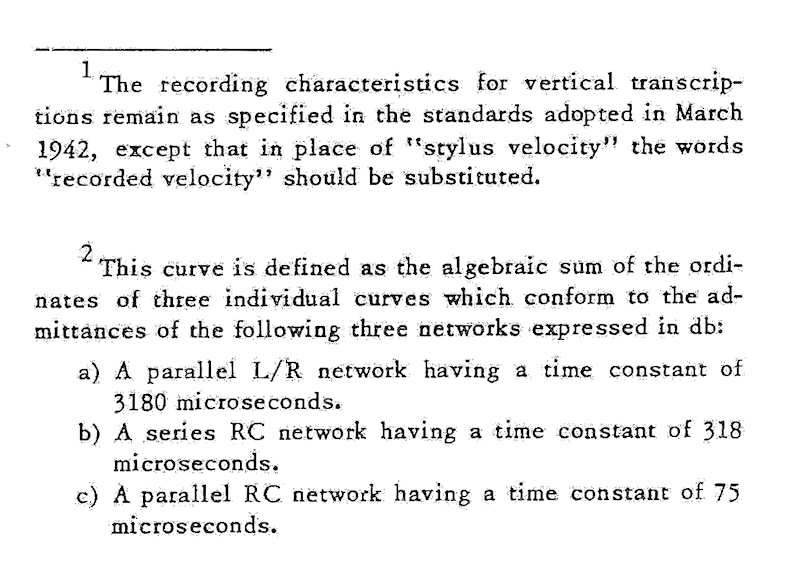
source: Supplement No.2 to NAB (NARTB) Engineering Handbook (Fourth edition, 1949): NARTB Recording and Reproducing Standards (June 1953), p.1-3-03.
縦振動盤向けの脚注1は、1949年版と同じ。
横振動盤向けの脚注2では、NARTBカーブを実現する回路構成について言及がある。
2 This curve is defined as the algebraic sum of the ordinates of three individual curves which conform to the admittance of the following three networks expressed in db:
a) A parallel L/R network having a time constant of 3180 microseconds.
b) A series RC network having a time constant of 318 microseconds.
c) A parallel RC network having a time constant of 75 microseconds.
2 このカーブは、3つの独立したカーブの値の代数和として定義され、以下の3つのネットワークのアドミタンスをdBで表したものとなる。
a) 3,180μs の時定数を持つ、並列L/Rネットワーク。
b) 318μs の時定数を持つ、直列RCネットワーク。
c) 75μs の時定数を持つ、並列RCネットワーク。
重低域ターンオーバー(ベースシェルフ)を実現するネットワークが「並列L/R回路」と書かれていることに要注目です。当時のプロフェッショナル市場では、録音EQ、再生EQともにパッシブLRCイコライザが主流であった、その名残りなのかもしれません。一方、当時も今も、民生用アンプなどに内蔵されているのはほとんどがアクティブRC再生イコライザです。
It is very important to notice the network for the low-bass turnover (bass-shelf) is specified as “a parallel L/R network”. It might be one of the vestiges that passive LRC EQs were mainly used in the professional fields, while the consumer preamplifiers at the time were equipped with active RC playback equalizers. Also, almost all phono preamplifiers in modern years are RC type.
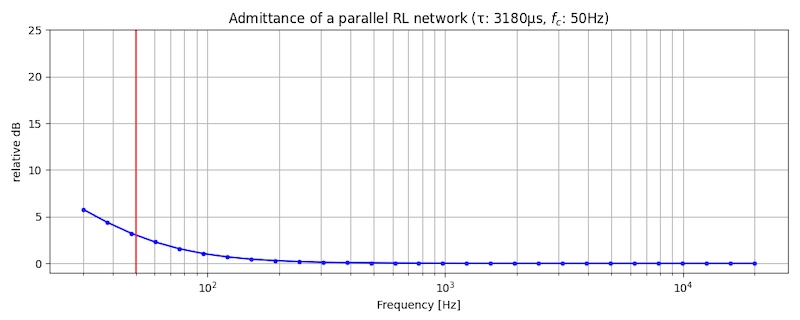
Admittance of a parallel RL network (τ: 3,180μs, fc: 50Hz)
graph plotted using PySpice and Matplotlib.
時定数3,180μs、ターンオーバー周波数 50Hz の並列RL回路のアドミタンス
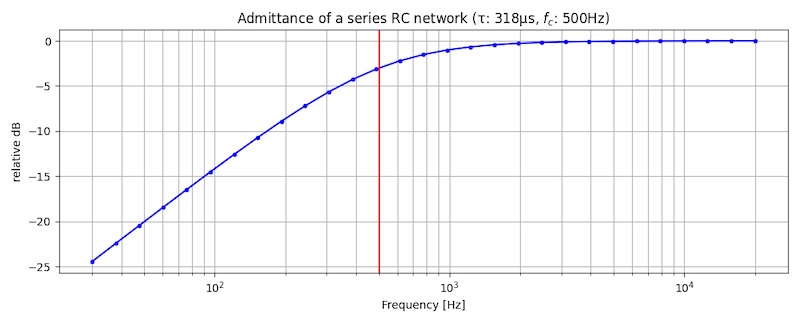
Admittance of a series RC network (τ: 318μs, fc: 500Hz)
graph plotted using PySpice and Matplotlib.
時定数318μs、ターンオーバー周波数 500Hz の直列RC回路のアドミタンス
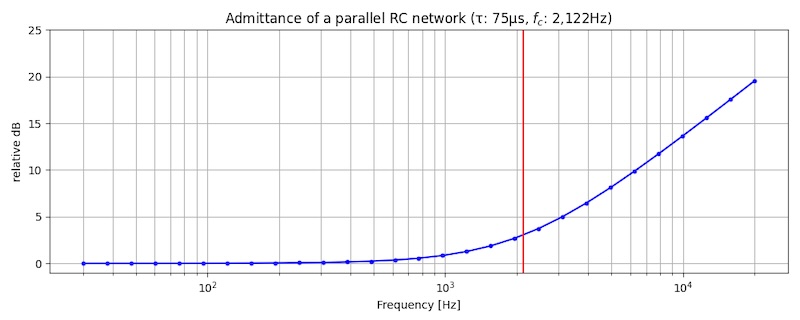
Admittance of a parallel RC network (τ: 75μs, fc: 2,122Hz)
graph plotted using PySpice and Matplotlib.
時定数75μs、ターンオーバー周波数 2,122Hz の並列RC回路のアドミタンス
当該標準規格文書には、1953年 NARTB 横振動盤向け録音カーブをプロットしたグラフが掲載されており、ここでも時定数(75μs, 318μs, 3,180μs)が明記されています。また、グラフは 30Hz〜15,000Hz まで伸びています。高域プリエンファシスが弱められたことにより、10,000Hz では相対ゲインが +13.75dB、15,000Hz では +17.17dB となっています。
The document in question includes a graph plotting the 1953 NARTB recording characteristic for lateral discs, where the time constants (75μs, 318μs and 3,180μs) are also specified. The graph also extends from 30Hz to 15,000Hz. The relative gain is +13.75dB at 10,000Hz and +17.17dB at 15,000Hz, due to the weakening of the high-frequency pre-emphasis.

source: “Figure 2: NARTB Lateral Disk Standard Recording Characteristic, Supplement No.2 to NAB (NARTB) Engineering Handbook (Fourth edition, 1949): NARTB Recording and Reproducing Standards (June, 1953), p. 1-3-10.
1953年NARTB標準規格文書に掲載された、横振動トランスクリプション盤用録音カーブのグラフ
一方、1942 NAB および 1949 NAB の時には、50Hz〜10,000Hz が定義されていました。10,000Hz での相対ゲインは約 +16dB でした。
On the other hand, the previous 1942/1949 NAB defined 50Hz to 10,000Hz, with a relative gain of about +16dB at 10,000Hz.
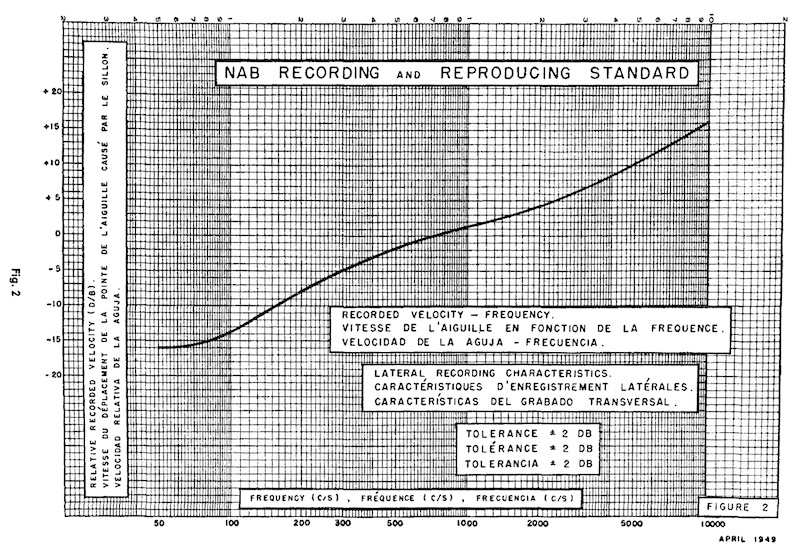
source: “The Recording and Reproduction of Sound”, Oliver Read, 2nd Edition, 1952, p.690
1949年NAB標準規格に掲載された、横振動トランスクリプション盤用録音カーブのグラフ
1953 NARTB 録音特性における、高域プリエンファシスの 100μs から 75μs への変更、これは先述のとおり、ホットスタイラス方式のカッターなど、記録性能の向上を念頭においた変化でした。また、1953 NARTB 録音特性自体が、RCA Victor が民生用レコードで1952年8月以降に既に採用していた、New Orthophonic 録音特性(Pt.17 セクション 17.5.2)と全く同じものでした。
The change in the high-frequency pre-emphasis from 100μs to 75μs in the 1953 NARTB Recording Characteristics, as mentioned earlier, was made with improved recording technologies and performance in mind, including the use of “Hot Stylus” recorders. Also, the 1953 NARTB Recording Characteristics was identical to the New Orthophonic recording characteristics (see: Pt.17 Section 17.5.2).
1952年後半〜1953年前半にリリースされたと思われる、“New Orthophonic” 特性にあわせた再生環境チェック用の10インチテストレコード、“New Orthophonic” Frequency Test Record (RCA Victor 12-5-49) を入手しました。
I obtained the 10-inch record “New Orthophonic” Frequency Test Record (RCA Victor 12-5-49), possibly released in late 1952 – early 1953, for adjusting reproducing equipments to the proper response for playing this recording characteristic.
何種類かバリエーションが存在する ようですが、私が入手したのはジャケット付片面盤です。
There are several variations known to exist, but the version I obtained is a single-sided disc with a cardboard jacket.
from my own collection
from my own collection
ジャケット表は、New Orthophonic 録音特性のグラフ(30Hz〜15,000Hz)で、裏ジャケのライナーノーツでは、New Orthophonic 録音特性を実現する並列LRネットワーク (3,180μs)、直列RCネットワーク (318μs)、並列RCネットワーク (75μs) の簡易回路図が掲載されています。
Plotted graph of the New Orthophonic recording characteristic (30Hz to 15,000Hz) is printed on the front cover, while the liner-notes on the back cover describes the recording characteristic, with the simplified schematics of parallel L/R network (3,180μs), series RC network (318μs) and parallel RC network (75μs).
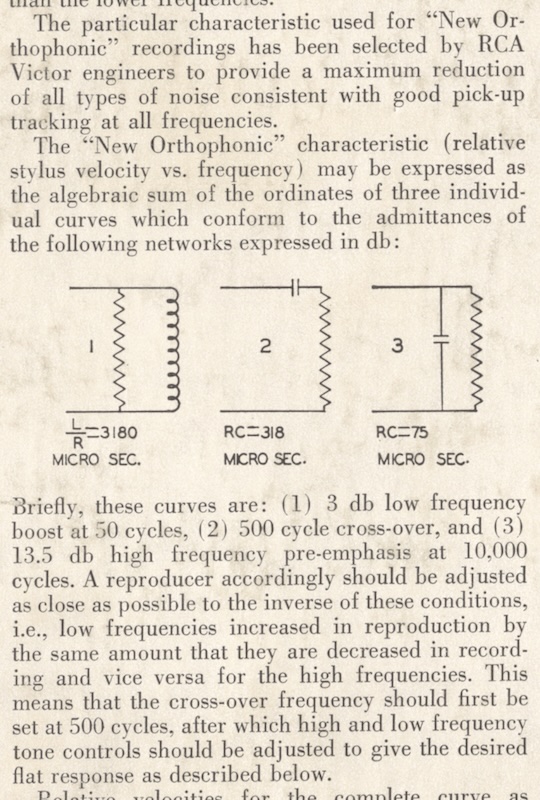
“New Orthophonic Frequency Test Record” (RCA Victor 12-5-49)
paragraphs describing the recording characteristic with the simplified LRC networks, in the very similar way as in the 1953 NARTB
1953 NARTB録音特性と全く同じ簡易LRC回路で New Orthophonic 特性を解説するライナーノーツ
つまり、1953 NARTB 録音特性とまったく同じ定義となっており、1953 NARTB 録音特性が RCA Victor New Orthophonic 録音特性そのものであることを示しています。
This clearly proves that, the New Orthophonic recording characteristic is identical to the 1953 NARTB recording characteristic, because the definition of the curve is completely identical.
18.3.4 NARTB Vol. Guide To Disk Standards (The Billboard, September 19, 1953)
この3ヶ月後、The Billboard 1953年9月19日号 に、NARTB 録音再生標準規格策定のニュース記事が掲載されました。
Three months after the approval, the September 19, 1953 issue of The Billboard carried a news article about the publication of the NARTB Recording and Reproducing Standards.
「今週発表された」とありますが、6月19日はあくまで内部的に正式承認された日であり、一般に広くアナウンスされたのがこの9月のタイミングだったのかもしれません(詳細不明)。
This article mentions the standard was published “this week”. So I guess that the Standards were approved internally on June 19, then widely published in September (detail unknown).
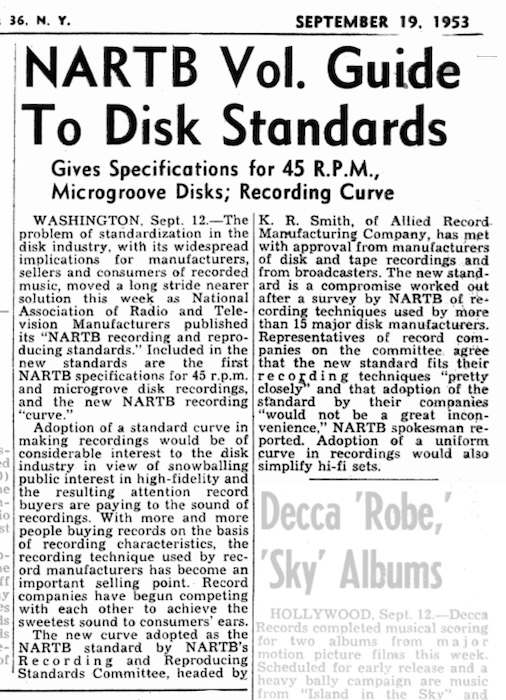
WASHINGTON, Sept. 12. — The problem of standardization in the disk industry, with its widespread implications for manufacturers, sellers and consumers of recorded music, moved a long stride nearer solution this week as National Association of Radio and Television Manufacturers published its “NARTB recording and reproducing standards.” Included in the new standards are the first NARTB specifications for 45 r.p.m. and microgroove disk recording, and the new NARTB recording “curve.”
ワシントン発、9月12日付 — ディスク業界における標準規格の問題は、レコード音楽の製造者・販売者・消費者に広範な影響を及ぼすが、解決に一歩近づくこととなった。全米ラジオ・テレビ事業者協会(NARTB)が今週、「NARTB 録音・再生標準規格」を発表したのだ。この新規格には、45回転盤およびマイクログルーヴ盤の録音規格が含まれるほか、新しいNARTB録音「カーブ」も含まれている。
Adoption of a standard curve in making recordings would be of considerable interest to the disk industry in view of snowballing public interest in high fidelity and the resulting attention record buyers are paying to the sound of recordings. With more and more people buying records on the basis of recording characteristics, the recording technique used by record manufacturers has become an important selling point. Record companies have begun competing with each other to achieve the sweetest sound to consumer’s ears.
雪だるま式に増加する大衆のハイ・フィデリティへの関心と、その結果としてレコード購買層がレコードの音に注目するようになったことを考えれば、(ディスク)録音時における標準カーブの採用は、レコード業界にとっては大きな関心事であろう。録音特性に基づいてレコードを購入する人が増えており、各レコードレーベルが使用する録音技術は重要なセールスポイントとなっている。消費者の耳にとって最も甘美な音を届けるべく、各レーベルは互いに競争を始めた。
The new curve adopted as the NARTB standard by NARTB’s Recording and Reproducing Standards Committee, headed by K.R. Smith, of Allied Record Manufacturing Company, has met with approval from manufacturers of disk and tape recordings and from broadcasters. The new standard is compromise worked out after a survey by NARTB of recording techniques used by more than 15 major disk manufacturers. Representatives of record companies on the committee agree that the new standard fits their recording techniques “pretty closely” and that adoption of the standard by their companies “would not be a great inconvenience,” NARTB spokesman reported. Adoption of a uniform curve in recordings would also simplify hi-fi sets.
Allied Record Manufacturing 社の K.R. Smith 氏が委員長を務める NARTB 録音・再生標準規格委員会が、NARTB 標準規格として採用した新しいカーブは、ディスク録音・テープ録音を行う企業や、放送局からも賛同を得ている。この新しい規格は、NARTB が 15以上の主要レコードレーベルが使用している録音技術を調査した結果に基づいた、妥協の産物である。NARTB のスポークスマンによると、委員会に参加するレコード会社の各代表は、この新規格が自社の録音技術に「かなり近い」ものであり、各社がこの規格を採用しても「大きな不具合はないだろう」と同意しているとのことである。レコードの記録カーブが統一されることになれば、ハイファイセットも簡素化されることとなる。
“NARTB Vol. Guide To Disk Standards”, The Billboard, Sep. 19, 1953, p.14.NARTB 録音再生標準規格はあくまで放送局向けの規格ですが、同じく標準規格化が望まれている民生用レコードの世界にも、今回の規格策定の(良い)影響があると希望する、というトーンで書かれているように読み取れる気がします。
Although the NARTB Recording and Reproducing Standards was for broadcasters and broadcasting industry, it seems to me that the one of the news is that people were hoping to have a (positive) impact on the world of consumer records, for which standardization had also been desired.
18.4 1954 AES Standard Playback Curve
1951年1月に AES 標準再生カーブを提唱した Audio Engineering Society は、この 1953 NARTB 録音再生標準規格策定を受け、動き出します。
Audio Engineering Society, which proposed the AES Standard Playback Curve in January 1951, move on with the formulation of the 1953 NARTB Standards.
それも当然のことで、NARTB に所属する企業やエンジニア、AES 学会に所属するエンジニアは、多くが重なり合っていたからです。このことは、Pt.16 セクション 16.4.1 で触れた通りです。
That is not surprising, since many of the companies and engineers belonging to NARTB and AES overlapped. (see also: Pt.16 Section 16.4.1)
18.4.1 New Recording Characteristic (Audio Engineering, July 1953)
まず、Audio Engineering 誌 1953年7月号の編集コラムに、NARTB 標準規格発表を受けた所感が掲載されました。
First of all, an editorial column in the July 1953 issue of Audio Engineering magazine published the thoughts on the announcement of the NARTB Standards.
当該編集コラムの執筆者は、恐らくは当時の Audio Engineering 編集長 C.G. McPround 氏でしょう。McPloud 氏は、トーキー映画黎明期に Paramount Pictures で13年間勤務し、当時は映画スターの自宅オーディオシステムのセットアップも行っていたそうです。その後第二次世界大戦中は海軍でソナーシステムの開発に従事、戦後出版業務に進出、Audio Enginerring 誌の創刊に関与、その後1949年から2代目編集長となりました。学会 AES の代表も務め、後年には IEEE の終身会員でもありました。(JAES 1986年6月号に掲載された追悼記事)
The author of the editorial column would arguably be C.G. McProud, editor and publisher of Audio Engineering Magazine at the time. Mr. McPloud worked at Paramount Pictures in the early days of “talkies”, and he even “designed and installed music systems in the homes of many movie greats in the early 1930s”. Then during the WWII, he worked on the development of sonar systems for Navy. After the war, he entered the magazine field, and became management editor of Audio Engineering. In 1949 he became the second editor-in-chief. He also served as Audio Engineering Society’s president in 1952; he also was a life member of IEEE. (obituary article published in the June 1986 issue of the Journal of the AES)
ちなみに、学会としての AES の論文や文書は、1952年までは Audio Engineering 誌の学会セクションとして掲載 されていましたが、Audio Engineering 誌から独立し、1953年1月からは「Journal of the Audio Engineering Society」として発行されるようになりました(1953年 Vol.1 〜 2001年 Vol.49 の論文誌一覧)。
By the way, papers and documents of the AES as a society were published in the society section of Audio Engineering magazine until 1952: then starting from January 1953, the society started to publish its own “Journal of the Audio Engineering Society” (see: list of JAES from 1953 Vol.1 to 2001 Vol.49).
A Good Twenty-Five per cent of the correspondence received each month deals with the recording characteristics — the principal question in the minds of the writers being “What characteristic is the Doakes Recording Company using at the present time?” Our regular answer to questions of this type is that it does not make any difference what characteristic is being used — simply provide enough flexibility in the reproducing system for all characteristics and then adjust the controls so the reproduction sounds good.
(本誌編集部に)毎月送られてくる手紙の25パーセントは、録音特性に関するものである。それらの手紙の筆者の抱える主な疑問というのは、「なんちゃらレコード社が現在使用している特性はなにですか?」というものである。この種の質問に対する私たちのいつもの回答は次の通りである。「どの特性が使用されているか、そのことは特に違いはない。」「単に、再生システム側で、あらゆる特性に対する十分な柔軟性を持たせ、その上で、再生音が良く聞こえるように(トーン)コントロールを調整すればいい。」
This answer — we will admit frankly — is not just what the correspondent wants. He would usually prefer that we would state the turnover frequency in cps, the rolloff in db at 10,000 cps, and the bass pre-emphasis, if any. We have endeavoured to state on every occasion where the question comes up that such information is not only unobtainable — as it apparently isn’t in most instances — but that the movement of a microphone by as little as three feet will make more difference than the few-db changes in the recording characteristic that occur as the art of recording is advanced.
この回答は、質問者が求めるものではないことは、率直に認めよう。手紙を書いてくれた人は、ターンオーバー周波数 (cps)、10,000 cps でのロールオフ値 (dB)、そして(もしあれば)低域プリエンファシス、の明記を望んでいるであろう。このような質問が届くたびに何度も述べてきたが、そのような情報は(ほとんどの場合)入手不可能であるだけではなく、録音技術の進歩により生じる録音特性の数dBの違いより、わずか3フィートマイクを移動する方がより大きな違いをもたらすのである。
“New Recording Characteristic”, Editor's Report, Audio Engineering, July 1953, p.16このように、当誌に寄せられる録音再生カーブに関する質問の多さをなげいた(笑)あと、同号に掲載された RCA Victor の R.C. Moyer 氏による有名な解説記事「Evolution of a Recording Curve」を読んで、「録音特性」を正しく理解すべし、と続きます。
In this way, the editorial column lambastes the many questions they continuously receives about recording / reproducing curves. Then the column continues that “we commend for careful reading by every user of records the article commencing on page 19”, which is the famous article “Evolution of a Recording Curve” by R.C. Moyer of RCA Victor.
続いて、1951 AES 標準再生カーブが(多くのレーベルからの支持はあったものの)業界全体では支持されなかった技術的な理由について述べられています。すなわち、1942/1949 NAB カーブや Columbia LP、そして RCA Victor New Orthophonic には存在していた、重低域ターンオーバーが含まれていなかったことです。
The editorial column then discusses the technical reasons why the 1951 AES Standard Playback Curve was not supported by the industry as a whole, although generally accepted by many labels: the lack of low-bass turnover, which was present in the 1942/1949 NAB curve, Columbia LP curve, and RCA Victor’s New Orthophonic curve.
In considering the recording characteristic, it should be pointed out that the AES playback curve endeavored to clarify the requirements at the time it was first introduced. The fundamental premise behind the AES curve was that a fixed basic reproducing characteristic should be employed by every manufacturer in his monitoring circuits, and that the records should be so recorded that they would sound right (to the producer) with a system equalized in this manner. Variations to suit the individual listener could then be introduced by means of the bass and treble tone controls, and, if desired, by sharp cutoff filters. While the AES playback curve received considerable support from many of the manufacturers, it is admitted that not all of the manufacturers went along, and for several valid reasons.
録音特性を考える上で、AES 再生カーブは、そのカーブが提唱された当時の要求を明確にしようと努力したものであることを指摘しておく。AES カーブの背後にある基本的な考え方というのは、どのメーカもモニタ回路に一定の基本的な再生特性を採用すべきであり、レコードはこの方法でイコライズされたシステムで(プロデューサにとって)正しく聞こえるように録音されるべき、というものであった。その上で、低域と高域のトーンコントロールによって、個々のリスナーに合わせた音に変更したり、また必要であればシャープなカットオフフィルタを導入したりできる。AES 再生カーブは多くのメーカからかなりの支持を得たが、全てのメーカが賛同したわけではなかったし、それにはいくつか正当な理由があったことは認める。
The vast majority of phonograph records are reproduced on equipment which is not entirely free from rumble. With the AES curve, low-frequency equalization continued to increase, reaching 26 db at 20 cps, and still more as the frequency lowered. Furthermore, due to circumstances beyond anybody’s control, low-frequency response from crystal pickups began to drop off somewhere below 100 cps when used with practical values of grid resistors. Therefore, improved low-frequency response could be obtained if a small amount of low-frequency pre-emphasis were introduced. This would result in less hum and rumble with even the highest quality equipment, and in better bass response with crystal pickups — which everyone knows outnumber the magnetics by a factor of at least 10 to 1.
大半のレコードは、ランブルが完全には排除されていない機器で再生されている。AES カーブにおいては、低域のイコライジングは増加し続け、20Hz では 26dB に達し、周波数が下がればそこから更に増加する。それに加えて、実用的な値のグリッド抵抗を使用した場合のクリスタルカートリッジでは、誰にもコントロールできない事情により、低域レスポンスは 100Hz を下回るあたりから落ち始める。したがって、低域プリエンファシスを少々導入することにより、(クリスタルカートリッジでの再生時の)低域レスポンスが改善されることになる。その結果、最高品質の機器でもハムやランブルの発生を低減させられ、(誰もが知る通り、マグネットカートリッジの最低でも10倍は普及している)クリスタルカートリッジでは低域のレスポンスが向上することとなる。
“New Recording Characteristic”, Editor's Report, Audio Engineering, July 1953, p.16この編集コラムが書かれた1953年7月時点では、民生用機器において、クリスタルカートリッジの方がマグネットカートリッジの10倍以上使われていた、というのは、非常に興味深いくだりですね。
It is very interesting to note that as of July 1953, when this editorial column was written, crystal pickups were widely used in consumer equipments ten times more than magnet pickups.
そして最後に、1942/1949 NAB カーブに対する技術的な批判の話、今回の 1953 NARTB カーブに対する所見が述べられ、コラムが締められています。
Finally, the column concludes with a discussion of the technical criticisms of the 1942/1949 NAB curve, and the opinions on the 1953 NARTB curve.
The old NAB recording characteristic has come in for its share of criticism during the last few years — the main objection being excessive high-frequency pre-emphasis. However, a new recommendation has been circulated by NARTB and it seems probable that this recommendation will become a standard within a short time, eliminating the AES playback curve and the old NAB curve.
古い(1942年版、1949年版の)NAB 録音特性は、ここ数年間批判にさらされてきた。その主たる批判は、過剰すぎる高域プリエンファシスに対してのものである。しかし、NARTB による新しい提案が出回っていることから、この提案が近々標準規格となり、(1951 旧)AES再生カーブと(1942/1949)旧NABカーブが排除される可能性が高いと思われる。
The proposed NARTB standard is identical with the New Orthophonic curve now in use by RCA Victor and fully described by Mr. Moyer. Maybe this will end forever the difference in recording characteristics and simplify equipment design and operation.
提案されている NARTB 標準規格は、現在 RCA Victor が使用している New Orthophonic カーブと同一である。New Orthophonic は(本誌今月号に掲載されている) Moyer 氏(の記事)によって完全に説明されている。恐らくは、(今回の標準規格策定により)録音特性の違いは永遠になくなり、機器の設計と操作が簡便になるであろう。
“New Recording Characteristic”, Editor's Report, Audio Engineering, July 1953, p.16やはり、この Audio Engineering 誌の編集コラムにおいても、放送局用の新しい標準規格により、民生用機器への良い影響があることを期待しているように読めます。
After all, even this editorial column in Audio Engineering magazine reads like a hope that the new (1953 NARTB) standards for broadcasting industry would have a positive impact on consumer equipment as well.
本記事でも過去に何度も紹介している、R.C. Moyer 氏の有名な解説記事「Evolution of a Recording Curve」は、1953 NARTB 録音再生標準規格が策定されたタイミングで発表された、RCA Victor が過去に使ってきた録音カーブの歴史と New Orthophonic カーブについての技術解説記事で、必読です。
R.C. Moyer’s “Evolution of a Recording Curve”, also in the July 1953 issue of Audio Engineering magazine, is a must-read, introducing the history of recording curves RCA Victor had historically used, as well as the technical description of New Orthophonic recording characteristic.
以下、New Orthophonic 録音特性の時定数を解説するパートを引用します。
Below are the quotes from the Moyer’s article, describing the time constants used for the New Orthophonic recording characteristic.
The expression “75-microsecond pre-emphasis” indicates that high frequencies are pre-emphasized according to a curve which conforms to the admittance of a parallel resistor and capacitor netowrk, with a time constant of 75 microseconds. The curve is +3 db at 2,120 cps and +13.7 db at 10,000 cps relative to low frequencies.
「75μsプリエンファシス」という表現は、75μsの時定数を持つ並列RCネットワークのアドミタンスに適合する曲線に従って高周波が増幅されることを表している。このカーブは、低周波に対して 2,120Hz で +3dB、10,000Hz で +13.7dB となるものである。
An ideal cutter characteristic as defined earlier may be represented by a curve which conforms to the admittance of a series RC network, where the time constant defines the crossover frequency. For a 500-cps crossover point T=318 microseconds. In a similar manner, low-frequency pre-emphasis may be expressed as a curve conforming to the admittance of a parallel resistor-inductor combination. For 3-db rise at 50 cps, for example, the time constant of the network is 3,180 microseconds.
先に定義した理想的なカッター特性は、直列RCネットワークのアドミタンスに適合する曲線で表すことができ、時定数がクロスオーバー周波数を定義する。500Hz のクロスオーバーポイントの場合、時定数 T は 318μsである。同様の方法で、重低域のプリエンファシスは、並列RLネットワークのアドミタンスに適合する曲線として表すことができる。例えば、50Hz で +3dB となる場合、ネットワークの時定数は 3,180μsとなる。
Evolution of a Recording Curve, R.C. Moyer, Audio Engineering, July 1953, pp. 19-22 & 53-54, 1953.Robert C. Moyer (R.C. Moyer) 氏は、1945年に RCA に入社、録音開発グループのマネージャを務めました。また、NARTB 録音再生標準規格委員会メンバでもあり、IRE や AES でも標準規格化に尽力した人物です。IRE シニアメンバ、そして AES フェローでもありました。
Robert C. Moyer (R.C. Moyer) joined RCA in November 1945, where he became Manager of the Recording Department group. He was a member of NARTB’s disc / magnetic recording committee, and he also worked standardization activities at IRE and AES. Mr. Moyer was a senior member of IRE, and AES Fellow.
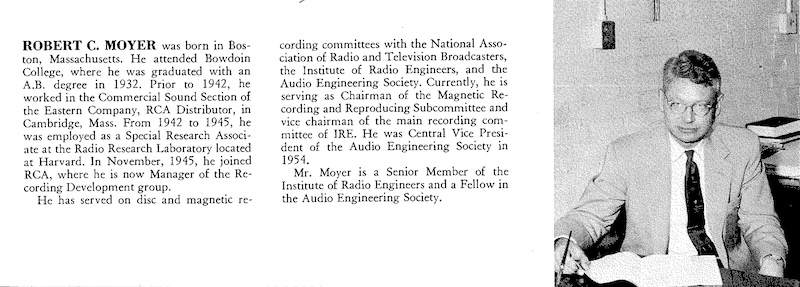
source: “Standard Disc Recording Characteristic”, RCA Engineer, Vol.3, No.2, Oct.-Nov. 1957, pp.11-13.
18.4.2 Standard Playback Characteristic for Lateral Disk Recordings (TS-1) (Journal of the Audio Engineering Society, January 1954)
1953年中に、AES 標準化委員会で、どのような議論が行われたのか、それを示す議事録や資料は公開されていません。
There are no published minutes or documents that show what discussions took place in the AES Standards Committee during 1953.
ともあれ、1953年12月21日、改訂版 AES 標準再生特性の暫定規格が承認され、論文誌 Journal of the AES 1954年1月号 (Vol.2, No.1) に掲載されました。AES 学会員からの試用フィードバックやコメントの受付期間として3ヶ月間が指定され、コメント締切日が1954年5月1日とされました。
Anyway, on December 21, 1953, the tentative standards for the revised AES Standard Playback Curve were approved, then published in the January 1954 (Vol.2, No.1) issue of the Journal of the Audio Engineering. A three-month period was designated for receiving any trials, feedbacks and comments from the society members. The deadline for comments was set for May 1, 1954.
このドラフトを提案しコメントを求める、という手順は、ASA (American Standards Association、米国規格協会、ANSI の前身) に示されたものに従っていること。また、IRE (Institute of Radio Engineers, 無線学会, IEEE の前身) や SMPTE (Society of Motion Picture and Television Engineers, 米国映画テレビ技術者協会) といった学会、RMTA (Radio Television Manufacturers Association, ラジオ・テレビ製造製造業者協会) といった業界団体、さらには個々の企業など、ASA に加盟する各団体とも連携してきたこと。これらがドラフト文書冒頭で説明されています。
The proposal for trial and for comment was based on the procedure that “laid out in broad outline by the American Standards Association” (the predecessor of ANSI). Also, AES was cooperating standards organizations nationally and internationally, via the ASA and its member bodies such as IRE (Institute of Radio Engineers), SMPTE (the Society of Motion Picture and Television Engineers), RTMA (Radio Television Manufacturers Associations) and individual companies.
さて、この改訂版 AES 標準再生特性においても、1953 NARTB と呼応するように、再生カーブは3つの曲線の合計として定義され、時定数も明記されています。
In the proposal of this revised AES Standard Playback Curve, the reproducing curve is also defined as the sum of three curves and three time constants, as in the 1953 NARTB Standards.
1953 NARTB と全く同じ時定数、全く同じ定義帯域(30Hz〜15,000Hz)であり、1953 NARTB を業界標準録音カーブ、1954 改訂版 AES 標準再生特性を業界標準再生カーブとするべく、関係者が動いていたことが伺えます。
It has exactly the same time constants as the 1953 NARTB; it has the definition of exatly the same frequency bandwidth (30Hz to 15,000Hz) as the 1953 NARTB. This arguably indicates that both parties were working to make the 1953 NARTB the industry standard recording characteristic, and to make the 1954 revised AES the industry standard reproducing characteristic.
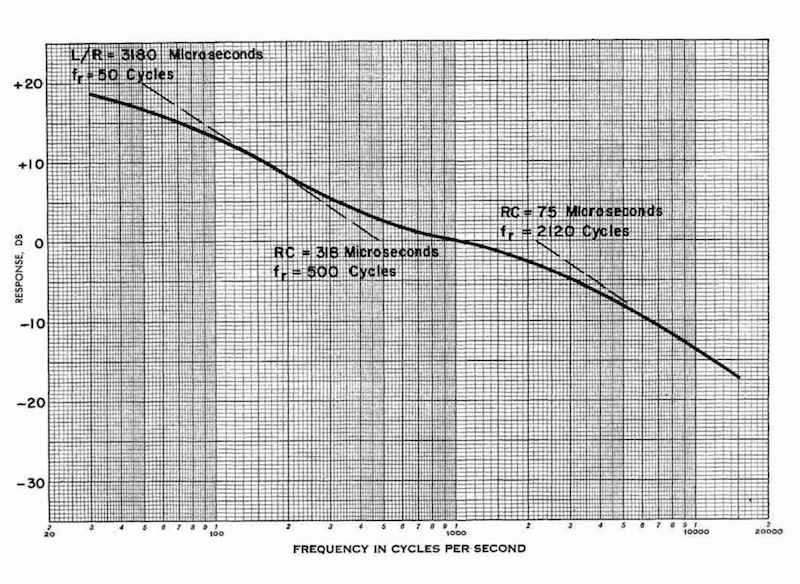
source: “The Proposed AES Standard: Standard Playback Characteristic For Lateral Disk Recordings”, Journal of the Audio Engineering Society, Vol. 2, No. 1, January 1954, pp.3-7.
1.2 Curve Deviation. The characteristic curve is defined as the algebraic sum of the ordinates of three individual curves which conform to the impedances of the following networks expressed in decibels (db):
Curve I. A parallel combination of a resistor and capacitor having a time constant of 75 μsec. This curve provides high-frequency rolloff (-3db at 2120 cps and -13.7 db at 10,000 cps).
Curve II. A series combination of a resistor and capacitor having a time constant of 318 μsec. This curve provides low-frequency boost, rising at the rate of 6 db per octave below a 500-cps crossover point (+3 db at 500 cps and +20 db at 50 cps).
Curve III. A parallel combination of a resistor and inductor having a time constant of 3180 μsec. This curve provides a very-low-frequency rolloff resulting in a departure of 3 db at 50 cps from the 6 db per octave slope of Curve II.
The curve, as described above and illustrated in the attached graphs, represents the desired amplifier output to be obtained when playing a constant-velocity frequency record.
1.2 カーブ偏差 特性カーブは、3つの独立したカーブの値の代数和として定義され、以下の3つのネットワークのインピーダンスをdBで表したものとなる。
カーブI. 75μs の時定数を持つ、並列RCネットワーク。このカーブは、高域ロールオフとなる(2,120Hz で -3dB、10,000Hz で -13.7dB)。
カーブII. 318μs の時定数を持つ、直列RCネットワーク。このカーブは、低域ブーストとなり、クロスオーバー周波数である 500Hz 以下で1オクターブあたり6dB増幅となる(500Hz で +3dB、50Hz で +20dB)。
カーブIII. 3,180μsの時定数を持つ、並列RLネットワーク。このカーブは、低域のロールオフとなり、カーブIIの6dB/オクターブスロープから 50Hz で 3dB の差分となる。
上述したカーブ(および添付のグラフに示した曲線)は、定速度特性で記録された周波数レコードを再生した際の望ましいアンプ出力を表している。
The Proposed AES Standard: Standard Playback Characteristic For Lateral Disk Recordings, Journal of the Audio Engineering Society, Vol. 2, No. 1, January 1954, pp.3-7AES標準再生特性は、1953 NARTB 録音特性に呼応する再生特性ですから。そのグラフは、アドミタンスではなくその逆数である インピーダンス をdBで表したもの、と明記されています。
Since the AES Standard Playback Characteristic corresponds to the 1953 NARTB Recording Characteristics, the document clearly states that the plotte graph conforms to the impedances in dB, not to the admittances.
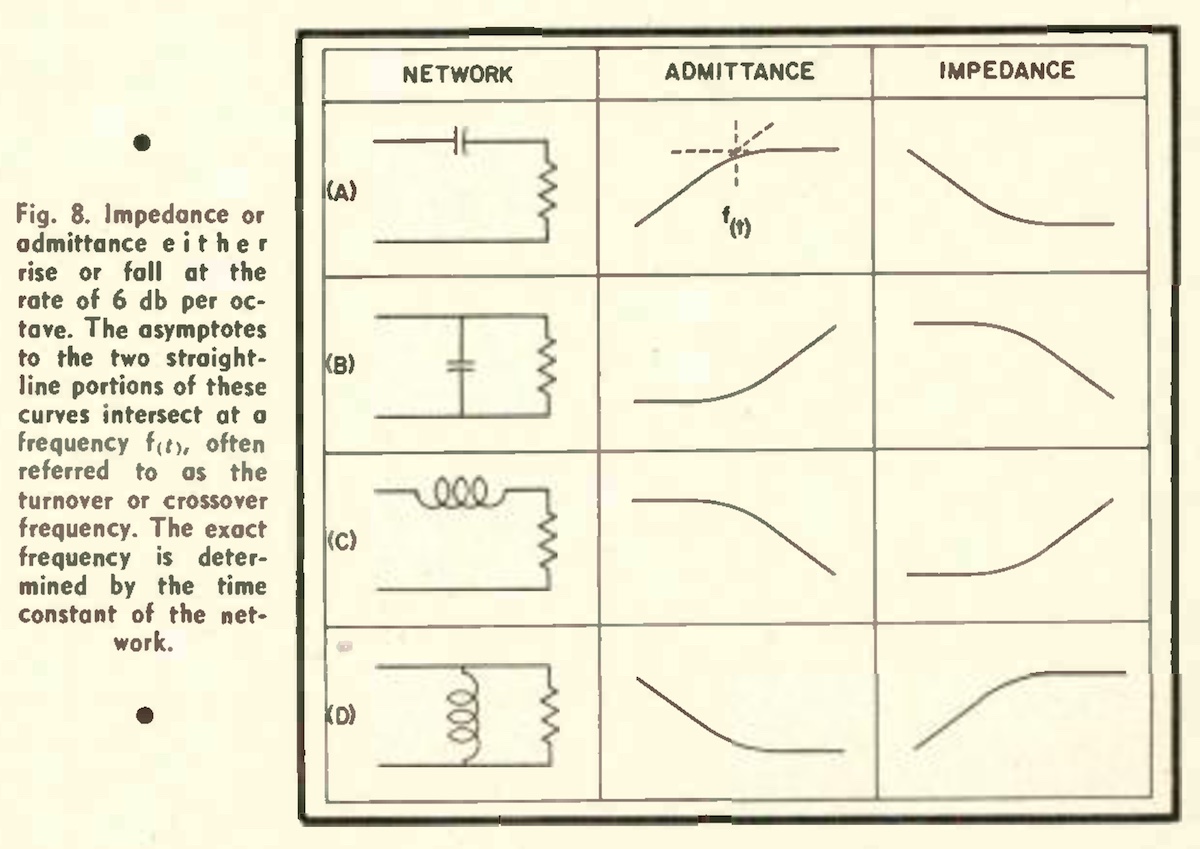
source: “Evolution of a Recording Curve“, R.C. Moyer, Audio Engineering, July 1953, pp. 19-22 & 53-54, 1953.
Audio Engineering 誌 1953年7月号に掲載された、RIAAカーブについての解説記事より。
直列RC / 並列RC / 直列LR / 並列LR 回路の、アドミタンスとインピーダンスを図解するイラスト。
The figure llustrating admittances and impedances of {series, parallel} {RC, LR} circuits.
18.4.3 Letters to the Editor: Disk Standard Comment (Journal of the Audio Engineering Society, April 1954)
AES 論文誌の翌号(1954年4月号、Vol.2, No.2)の投稿欄には、あの H.H. Scott (Hermon Hosmer Scott) 氏から、改訂版 AES 標準再生特性ドラフトに対するコメントが寄せられました。
In the next issue of the Journal of the AES (Apr. 1954, Vol.2, No.2), that Mr. H.H. Scott (Hermon Hosmer Scott) contributed his comments on the tentative draft.
可変フォノイコ内蔵アンプの製造販売も行っていた H.H. Scott 社(Pt. 17 セクション 17.7.7 参照)のオーナーが寄せたコメントは、当時の開発者・研究者の意見を代表するものでした。
The comment made by the owner of the H.H. Scott, Inc. (see: Pt.17 Section 17.7.7), manufacturer consumer audio equipment including amplifiers with built-in variable phono equalizers, was representative of the opinions of developers and researchers at the time.
すなわち、「旧AESカーブには存在していなかった重低域ターンオーバーが追加されたことは、ランブルや偏心への対策として望ましいこと」と同調する一方、「高域プリエンファシス(すなわち再生時の高域デエンファシス)が旧AESカーブより強められたことは望ましくなく、間違った方向に進んでいる可能性がある」と否定的に捉えたものです。
That is to say, the agreement of “the addition of low-bass turnover, which was not present in the old AES curve, is desirable as a countermeasure against rumble and eccentricity”, while the negative comment of “stronger high-frequency pre-emphasis (i.e. high-frequency de-emphasis during reproducing) than that of the old AES curve is undesirable, and is possibly in the wrong direction”.
It has been my observation that among present commercial recordings the most obvious and consistent defect is a roughness in the high-frequency reproduction, which I have attributed (either rightly or wrongly) to the large amount of pre-emphasis being used. On this basis, it appears to me that the increase in pre-emphasis of the new NARTB curve orver the old AES curve is a disadvantage.
私の見るところ、現在市販されているレコード盤において最も明白で一貫した欠点は、高域の再生が荒いことである。これは(正しいか間違っているかはさておき)強いプリエンファシスの使用に起因していると私は考えてきた。この点において、旧AESカーブに比べて新しいNARTBカーブでプリエンファシスが強くなっていることは不利益である、と私には思える。
Letters to the Editor: Disk Standard Comment, by H.H. Scott, Journal of the Audio Engineering Society, Vol. 2, No. 2, April 1954, p.111しかし、すでに New Orthophonic カーブが NARTB 標準規格として採用されてしまったこともあってか、高域プリエンファシスを弱めた(再生時の高域デエンファシスを弱めた)カーブに訂正されることはなく、NARTB 録音特性に完全に対応するまま改訂版AES標準再生特性の承認を迎えることとなります。
Nevertheless, probably because the New Orthophonic curve had already been adopted as the recording characteristic of the 1953 NARTB Standards, lower high-frequency pre-emphasis (i.e. weaker de-emphasis during reproducing) was never adopted. Then the revised AES Standards that correspond to the 1953 NARTB Recording Characteristic was to be approved soon.
18.4.4 AES Disk Standard Approved (Journal of the Audio Engineering Society, October 1954)
そして、1954年6月15日、AES 理事会によって、改訂版AES標準再生特性が承認され、規格番号 AES: TSA-1-1954 とされました。
Then on June 15, 1954, the AES board of governors approved the revised AES Standard Playback Characteristic, with the standard number AES: TSA-1-1954.
AES: TSA-1-1954 は、ASA(米国規格協会、のちの ANSI)に公式に送付され、米国の標準規格として採用してもらうべく依頼している、とも書かれていますが、これが ASA の標準規格になった形跡は見つかりませんでした。
The news says that AES: TSA-1-1954 “has been formally submitted to the AMerican Standards Association with the request that it be processed as an American Standard”, but I could not find any evidence of it being accepted as an American Standard.
18.5 1954 RIAA Standard Recording and Reproducing Characteristic
そして、1年以上に渡る歴史探訪の末、やっと RIAA 規格に到達しました。ここまで長かったです(笑)
So, over one year of my studies and researches, I have FINALLY reached the story of the RIAA Standards — a long long way it really was.
RIAA の正式名称は Recording Industry Association of America、すなわち「全米レコード工業協会」または「全米レコード協会」です。
RIAA is an abbreviation of Recording Industry Association of America.
18.5.1 Press for Full Membership in RIAA, Disk Org (The Billboard, November 17, 1951)
RIAA の創立は 1952年とされています。その創立に向けた動きは、1951年暮れから報じられていました。
It is known that the RIAA was founded in 1952. The movement toward the RIAA establishment had been reported since late 1951.
The Billboard 1951年11月17日号 では、「12月から最初の活動を開始するであろう」と報じられています。
The Nov. 17, 1951 issue of The Billboard reports that the RIAA “should be swinging into the initial activity in the early part of December (1951)”.
18.5.2 Disk Industry Assn. Rapidly Becoming Set (The Billboard, December 8, 1951)
さらに 1951年12月8日号 の記事では、このレコード製造業界団体が、12月12日に初の公式会合を開くと報道されています。また、12月1日時点での参加メンバの一覧も掲載されています。
It was followed by the news article in the Dec. 8, 1951 issue, reporting that the association would “hold its first formal meeting on December 12”. Also found in this article is the list of the association members as of December 1st, 1951.
NEW YORK, Dec. 1. — The Record Industry Association of America, the phonograph record manufacturer organization which currently is in the process of formation, is well on its way toward becoming a reality. The RIAA will hold its first formal meeting on December 12 if current plans and membership anticipation materialize before that date.
ニューヨーク発、12月1日 — 現在設立準備中の、レコード製造業者による組織、全米レコード工業会は、その実現に向けて順調に進んでいる。RIAA は、現時点での計画と会員数の見込みが実現すれば、12月12日に最初の公式会合を開く予定である。
At this point, the association claims 25 actual manufacturer members covering about 30 different disk labels. These include all of the top firms and a sizable representation of the lesser waxers. The members at this point include:
現時点では、約30のレーベルをカバーする25名のディスク製造会社のメンバが加盟しているとのことである。この中には、トップクラスの企業(レーベル)が全て含まれており、小規模メーカ(レーベル)もかなりの数が含まれている。現時点でのメンバは以下の通りである。
Members
Columbia (and subsidiary Okeh), Decca (and subsidiary Coral), RCA Victor, Capitol, London, MGM, Mercury, Aladdin (and affiliates Score and Intro), Savoy (and affiliate Regent), Specialty, Vox, Dee Gee, Bartok, Cherokee, Circle, Dot, Folkways (and affiliate Ethnic), Life, Russell, Square, Dance Associates, Standard, Valentino, WCFM, and Windzor.
メンバ
Columbia (および某系レーベル Okeh), Decca (および某系レーベル Coral), RCA Victor, Capitol, London, MGM, Mercury, Aladdin (および傘下の Score と Intro), Savoy (および傘下の Regent), Specialty, Vox, Dee Gee, Bartok, Cherokee, Circle, Dot, Folkways (および傘下の Ethnic), Life, Russell, Square, Dance Associates, Standard, Valentino, WCFM, Windzor
18.5.3 First Board Meet Held by Disk Org (The Billboard, December 22, 1951)
The Billboard 1951年12月22日号では、上述の「12月12日の初の公式会合」の結果、「初の全体会合が(1952年)1月中旬までに開催されることが決まった」という記事が掲載されています。
Dec. 22, 1951 issue of The Billboard magazine reports that “the first general organizational meeting will be held sometime before mid-January (1952)”, as a result of the first formal meeting on December 12, 1951.
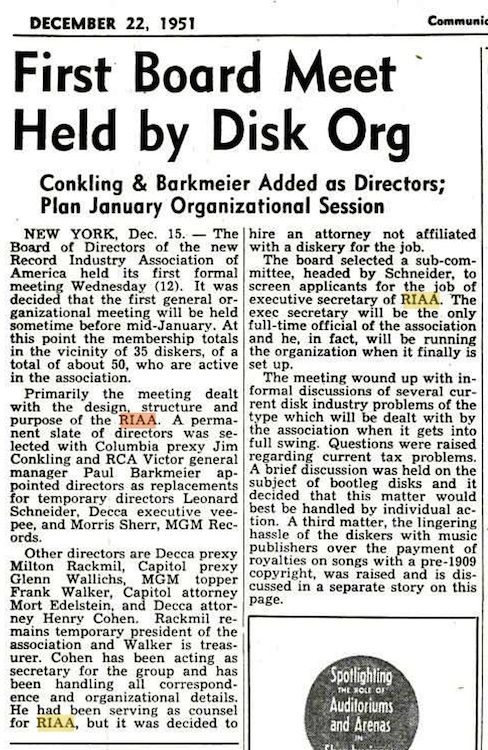
source: “First Board Meet Held by Disk Org”, The Billboard, December 22, 1951, p.15.
NEW YORK, Dec. 15. — The Board of Directors of the new Record Industry Association of America held its first formal meeting, Wednesday (12). It was decided that the first general organizational meeting will be held sometime before mid-January. At this point, the membership totals in the vicinty of 35 diskers, of a total of about 50, who are active in the association.
ニューヨーク発、12月15日 — 新たに誕生した米国レコード工業会の理事会が、12日(水)に初の公式会合を開いた。最初の全体会合は1月中旬までに開催されることが決定された。現時点では、この教会で活動しているレコード製造企業約50のうち、会員数は35近くとなっている。
Primarily the meeting dealt with the design structure and purpose of the RIAA. A permanent slate of directors was selected with Columbia prexy Jim Conkling and RCA Victor general manager Paul Barkmeier applinted directors as replacements for temporary directors Leonard Schneider, Decca executive vee-pee, and Morris Sheer, MGM Records.
会議では主に、RIAAの組織構成と目的について話し合われた。臨時理事の Leonard Schneider(Decca の代表取締役副社長)と Morris Sheer(MGM)の後任として、Jim Conkling(Columbia 会長)と Paul Barkmeier(RCA Victor ゼネラルマネージャ)が常任理事に選出された。
Other directors are Decca prexy Milton Rackmil, Capitol prexy Glenn Wallichs, MGM topper Frank Walker, Capitol attorney Mort Edelstein, and Decca attorney Harry Cohen.
他の理事は、Milton Rackmil(Decca 会長)、Glenn Wallichs(Capitol 会長)、Frank Walker(MGM トップ)、Mort Edelstein(Capitol 弁護士)、Harry Cohen(Decca 弁護士)である。
同記事では、1909年以前の楽曲の著作権について、またブートレグ盤の問題について、など、さまざまな非公式な議論が行われた、と書かれています。
The issue also reports that several industry problems were informally discussed at the meeting, including bootleg discs, legal status of pre-1909 tunes, etc.
18.5.4 John Griffin Named Exec Head of RIAA (The Billboard, February 23, 1952)
その後、1952年2月23日号の記事「John Griffin Named Exec Head of RIAA」では、レコード業界で幅広く活躍してきた John W. Griffin 氏がRIAA事務総長に選出された、と報告しています。
Later, in the February 23, 1952 issue, the article “John Griffin Named Exec Head of RIAA” reported that John W. Griffin, who has worked extensively in the record industry, was elected as RIAA’s executive secretary.
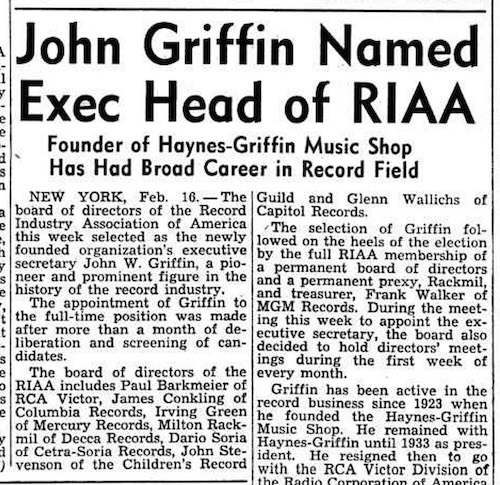
source: “John Griffin Named Exec Head of RIAA”, The Billboard, February 23, 1952, p.18.
記事によると Griffin 氏は、1923年に Haynes-Griffin Music Shop を設立、ラジオ部品製造販売事業で注目されたのち、1934年に RCA Victor に入社し東海岸営業部長を務め、さらに1938年には Columbia に移籍し副社長に就任しました。1940年には Scranton Record Company の共同オーナーとなり、Capitol が Scranton を1946年に買収したのちにも Capitol の理事会メンバとして数年残りました。
According to the article, Mr. Griffin “has been active in the record business since 1923 he founded the Haynes-Griffin Music Shop”. Then he went with the RCA Victor Division of the Radio Corporation of America (RCA), followed by his joining the American Record Corporation (ARC) as a vice president of sales in 1938, just before ARC was bought by CBS and became Columbia Records, Inc. Also in 1940, Mr. Griffin “became a part owner of the Scranton Record Company and became veepee in charge of sales”, before Capitol fully acquired Scranton in 1946. Since then, he “remained with Capitol for a period of three years as a member of the board ob directors”.
このように、Griffin 氏の事務総長選出は、RCA Victor、Columbia、Capitol と関わりの強い、米レコード業界での業績が評価されてのことでした。
Griffin’s election as executive secretary was in recognition of his accomplishments in the U.S. record industry, where he had strong ties to RCA Victor, Columbia and Capitol.
また同記事では、RIAA 理事会メンバも列挙しています。理事会メンバは、Paul Barkmeier (RCA Victor 副社長)、James Conkling (Columbia 社長)、Irving Green (Mercury 社長)、Milton Rackmil (Decca 社長)、Dario Soria (Cetra-Soria 創業者) 、John Stevenson (Children’s Record Guild 副社長)、Glenn Wallichs (Capitol 社長) と、当時の5大レーベルの代表を含むラインアップで構成されていました。
Also this article lists the member names of the RIAA board of directors: Paul Barkmeier (vice president of RCA Victor); James Conkling (president of Columbia); Irving Green (president of Mercury); Milton Rackmil (president of Decca); Dario Soria (founder of Cetra-Soria); John Stevenson (vice president of Children’s Record Guild); Glenn Wallichs (president of Capitol). Representatives of the five major labels at the time (RCA Victor, Columbia, Decca, Capitol and Mercury) were there.
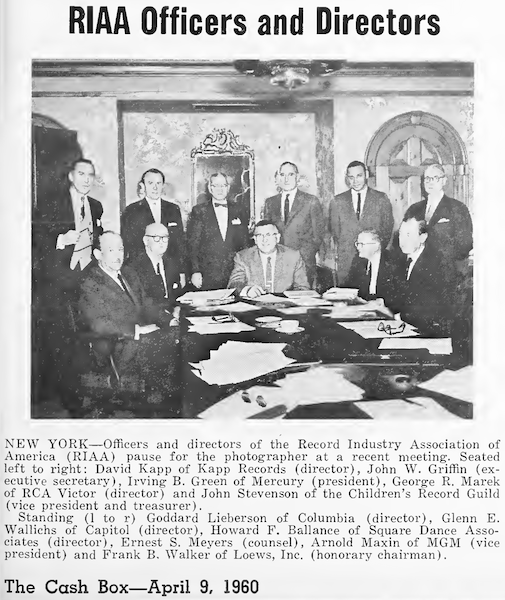
source: The Cash Box, April 9, 1960, p.51.
こちらは、RIAA創立8年後、1960年当時の RIAA 執行役・取締役を捉えた写真。
RIAA Officers and Directors, as of 1960.
18.5.5 Formation of the RIAA Engineering Committee (1953)
そして、RIAA 設立から1年後の1953年、RIAA 技術委員会 (RIAA Engineering Committee) が設立されます。
One year after the formation of RIAA — in 1953 — RIAA Engineering Committee was formed.
この RIAA 技術委員会の設立の経緯や議論の内容をまとめた回顧録が、1967年10月の AES 学会の国際会議で H.E. Roys (Henry Edward Roys) 氏によって口頭発表され、のちに AES 学会誌1968年1月号に掲載されました。
A memoir summarizing the history of the RIAA Engineering Committee and its discussions was presented orally by H.E. Roys (Henry Edwards Roys) at the October 1967 Conference of the AES, and later published in the January 1968 issue of the Journal of the AES.
発表者/執筆者の H.E. Roys 氏は、1950年代に RCA オーディオ技術部門に所属していたエンジニアでした(Pt. 12 セクション 12.2.5 や Pt. 8 セクション 8.3.3 も参照)。また、1949年 NAB 録音再生標準規格委員会のメンバとして活躍していました(Pt. 10 セクション 10.1.6 参照)。
The presenter/author, H.E. Roys, was an engineer of the RCA’s Audio Engineering Division in the 1950s (see: Pt.12 Section 12.2.5 and Pt.8 Section 8.3.3). He was also a member of the 1949 NAB Recording and Reproducing Standards Committee (see: Pt.10 Section 10.1.6).
さらに Roys 氏は、NAB/NARTB のみならず、AES、RIAA、EIA (Electronic Industry Association, 電子工業会)、ASA (American Standards Association, 米国規格協会、ANSI の前身) それぞれの標準規格化委員会にも関わっていました。(JAES 1989年3月号に掲載された追悼記事)
In addition, Mr. Roys had served on the standardization committees of the AES, RIAA, EIA (Electronic Industry Association), ASA (American Standards Association, the predecessor of ANSI), as well as NAB/NARTB. (see: obituary article published in the March 1989 issue of the Journal of the AES).
つまり、1940年代〜1950年代のレコード業界の技術標準規格化、そして設立直後の RIAA 技術委員会の動きを間近で見ていたであろう、当事者のひとりによる回顧録ということになります。
In other words, Mr. Roys’ presentation is a retrospective by one of the people who would have been closely involved in the record industry’s technical standardization efforts during the 1940s and 1950s, and in the workings of the RIAA’s Engineering Committee in its early years.
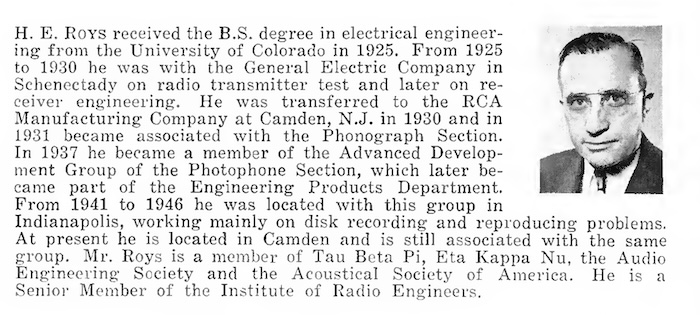
source: RCA Review, September 1953, p.458.
以下、Roys 氏の発表の導入部分を引用します。なぜ RIAA が(NAB/NARTB や AES とは別に)標準規格を作ろうとしたか、その目的が簡潔に記されています。
The following is a quote from the introduction to Mr. Roys’ presentation. It briefly describes the purpose of why RIAA wanted to formulate a standard of its own (separate from NAB/NARTB and AES).
INTRODUCTION
はじめに
The Engineering Committee of the Record Industry Association of America (RIAA) was formed in 1953. At that time microgroove records at operating speeds of 33⅓ and 45 rpm had been in existence for some five years and were replacing the 78 rpm records.
全米レコード工業会 (RIAA) の技術委員会は1953年に設立された。当時33⅓回転および45回転のマイクログルーヴレコードが誕生して5年ほど経っており、78回転盤を置き換えつつあった。
There were some record standards in existence due to the activities of the National Association of Broadcasters (NAB) and the Electronic Industries Association (EIA). Record engineers participated in these standardization activities but lacked the advantage of having their own organization, and hence the close cooperation that would permit them to better reflect their own views into standards.
当時、全米放送事業者教会 (NAB) や電子工業会 (EIA) の活動による、レコード規格がいくつか存在していた。レコードエンジニアは、これらの標準化活動に参加していたが、自分たちの組織(すなわち RIAA)を持つという利点を欠いていた。よって、自分たち(レコード製造側、レーベル側)の意見をよりよく標準に反映させるための緊密な協力体制に欠けていた。
To overcome this deficiency the Board of Directors of RIAA authorized the establishment of an RIAA Engineering Committee.
この欠陥を克服するため、RIAA の理事会は、RIAA 技術委員会の設立を承認した。
The RIAA Engineering Committee, by H.E. Roys, Journal of the Audio Engineering Society, Vol. 16, No. 1, January 1968, pp.18-20つまり、放送局の団体 (NAB) が決めた規格ではなく、オーディオ工学の学会 (AES) が決めた規格でもなく、レーベルやメーカなど米レコード製造業者の団体 (RIAA) が自主的に定めた規格としたい、ということになります。
Mr. Roys describes that the record industry (U.S. labels and manufacturers) needed its own standards, not formulated by the association of broadcasters (NAB), not formulated by the academic association of audio engineering (AES).
そして、録音再生規格そのものが問題であった(1953 NARTB 規格に反目して独自規格を策定しようとした)のではなく、レコード業界内の緊密な技術協力体制を確立するために、RIAA 技術委員会が誕生した ということになります。そうでないと、米国の全レコード業界で統一規格を採用するのが難しいと考えられたからでしょう。
Also, he describes that RIAA Engineering Committe was formed because the industry needed the closer cooperation in the record industry, not because the industry felt unhappy with the 1953 NARTB recording characteristic itself. This may suggest that RIAA thought the industry would not be able to adopt a unified standard in the industry, without the efforts by the RIAA Engineering Committee.
Roys 氏の回顧録には、非常に重要な客観的情報が記されています。
Mr. Roys’ memoirs contain very important objective information.
RIAA 技術委員会の第1回の会合は1953年1月16日に行われたこと。
The fact that the initial meeting of the RIAA Engineering Committee was held on January 16, 1953.
第1回会合の参加者は、Glenn Wallichs (Capitol, RIAA 理事)、John Griffin (RIAA 事務総長) に加えて、Edward H. Uecke (Capitol)、William S. Bachman (Columbia)、Charles Lauda (Decca)、H.I. Reiskind (RCA) ら、メジャーレーベルを代表する名だたるトップエンジニアであったこと。
The fact that the attendees of the Jan. 16, 1953 meeting were: Glenn Wallichs (Capitol, RIAA board of directors) and John Griffin (RIAA executive secretary); along with Edward H. Uecke (Capitol), William S. Bachman (Columbia), Charles Lauda (Decca), H.I. Reiskind (RCA).
この初回の会合では、レコード製造時・再生時の品質向上のために、レコード回転数とサイズの標準化を行うべし、と伝えられたこと。
The fact that the committee “was informed that the first order of business should be a recommendation for the standardization of record speeds and sizes”.
2回目の会合は1953年1月21日に行われたこと。
The fact that the second meeting was held on January 21, 1953
この2回目の会合から C. Robert Fine (Mercury 代理) も参加したこと。
The fact that C. Robert Fine (proxy for Mercury) had attended since the second meeting.
議論を「製造物の均一性・一様性」に集中させること。その結果、「まもなく市場からフェードアウトする78回転盤は対象とせず、マイクログルーヴ盤のみを対象とする」「レコードサイズは 7インチ / 10インチ / 12インチを対象にする」「センターホールのサイズは2種類のみとすること」「回転数は33⅓回転と45回転のみ対象とすること」が決定されたこと。
The fact that the discussion of the first two meeting was confined to “product uniformity”. As a result, it was decided that “only the microgroove record was to be considered” because the 78 rpm records would gradually be replaced with microgroove records; “three record diameters, 7, 10, and 12 in., were thought necessary to meet the program time requiments”; “two center hole sizes (…) were selected as the only ones requiring consideration”; and “two turntable speeds, 33⅓ and 45 rpm, were considered to be the only ones requiring consideration”.
1年間の議論と作業を経て、1954年1月29日 に “RIAA Standard Recording and Reproducing Characteristic (Bulletin E1)” が理事会によって承認されたこと。
The fact that, after one year of discussion and work, “RIAA Standard Recording and Reproducing Characteristic (Bulletin E1)” was approved by the RIAA board of directors on January 29, 1954.
ここで分かることは、当時の米国5大レーベルを代表する、錚々たるメンツのトップエンジニア5名が揃っていたことです。
These facts strongly tell us that the RIAA Engineering Committee consisted of five engineers — all of eminent stature — representing the five major U.S. labels of the time.
Edward H. Uecke 氏は、1946年に Capitol に入社、1948年に同社のチーフエンジニアとなりました。1955年に AES フェローとなったほか、1970年には「エンジニアとして、研究ディレクタとして、40年間にわたり録音と映画音声に多大なる貢献をした」ことで、AES名誉会員 となりました。(JAES 1972年6月号に掲載された追悼記事)
Mr. Edward H. Uecke joined Capitol Records in 1946, and became chief engineer in 1948. He also became a Fellow of the Audio Engineering Society, and was given an honorary membership in 1970 “for outstanding contributions to recording and sound motion pictures over a span of forty years, both as an engineer and research director” (see: obituary article published in the June 1972 issue of the Journal of the AES).
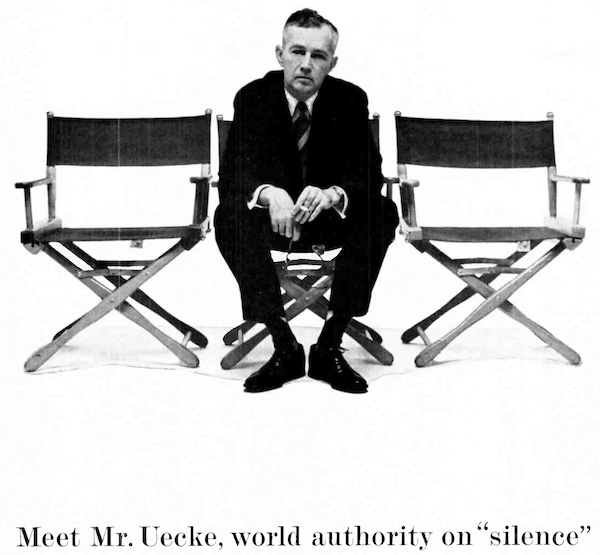
source: High Fidelity, Oct. 1955, p.121.
William S. Bachman 氏は、言うまでもなく幾多の重要な開発を行ったエンジニアで、General Electric 社在籍時にバリレラカートリッジを発明・開発したほか、1946年に入社した Columbia では LP 誕生に多大な技術的貢献を行ったチーフエンジニアです(Pt. 12 セクション 12.2.1 および 12.2.3 参照)。また、NAB標準規格の執行委員会メンバ、兼、プロジェクトメンバでもありました(Pt.10 参照)。1958年に AES フェローとなったほか、1973年には「長年に渡るステレオ録音への貢献をした」ことで AES名誉会員 となりました。(JAES 1996年9月号に掲載された追悼記事)
Mr. William S. Bachman was, without a doubt, a talented engineer who did numerous contributions in the recording industry. He developed a Variable Reluctance cartridge during his General Electric years; after he joined Columbia in 1946, he contributed to develop Long Playing microgroove records (see: Pt.12 Section 12.2.1 and 12.2.3). He was also a member of the NAB Standards Executive Committee and a member of several Project Group of the NAB Standards (see: Pt.10). He became an AES Fellow in 1958, and was given a honorary membership in 1973 “for his long record of achievements in stereophonic recording” (see: obituary article published in the September 1996 issue of the Journal of the AES).

(from Discogs contributed image)
Charles Lauda 氏は、1930年 WBS (World Broadcasting System) のチーフ録音エンジニアとなり、この会社が1943年に Decca によって買収されると、1965年に飛行機事故で亡くなるまで Decca のチーフエンジニアを務めました。Bachman 氏と同じく、NAB標準規格のプロジェクトメンバでした(Pt.10 参照)。そして1958年に AES フェロー となりました。(JAES 1966年1月号に掲載された追悼記事)
Mr. Charles Lauda became chief engineer for WBS (World Broadcasting System) which was purchased in 1943 by Decca. Since then, he was a chief recording engineer of Decca Records, until he was killed in the American Airlines crash on November 8, 1965. Like Mr. Bachman, he was a member of several NAB Standards Project Group. Then in 1958 he became an AES Fellow. (see: obituary article published in the January 1966 issue of the Journal of the AES).
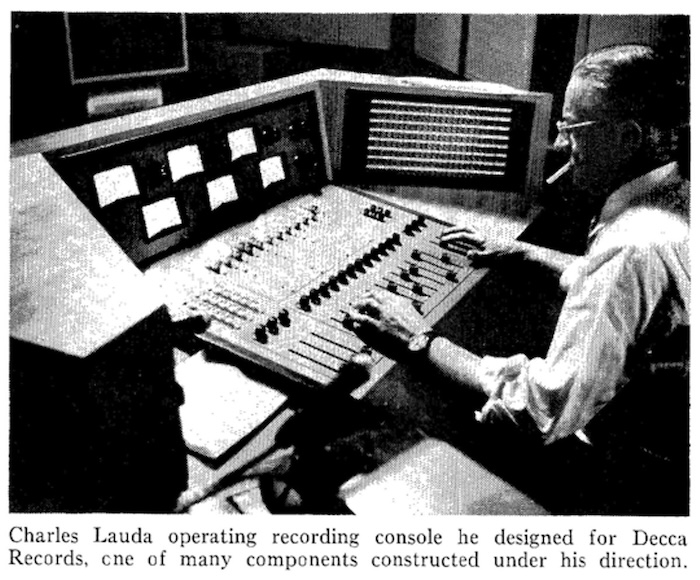
source: Journal of the AES, Jan. 1966, p.96
Hillel I. Reiskind (H.I. Reiskind) 氏は、RCA Victor のチーフエンジニアを長年務め、45回転盤やオートチェンジャーシステムの開発にも携わりました(Pt. 13 セクション 13.2.3 参照)。NAB標準規格の執行委員会メンバも務めました(Pt.10 参照)。1952年に AES フェロー となりました。
Mr. Hillel I. Reiskind (H.I. Reiskind) had long been chief engineer, Record Department (RCA Victor) of RCA. He contributed the deveopment of 45 rpm microgroove records as well as dedicated record changer system (see: Pt.13 Section 13.2.3). He also was a member of the NAB Standards executive committee (see: Pt.10). He became an AES Fellow in 1952.
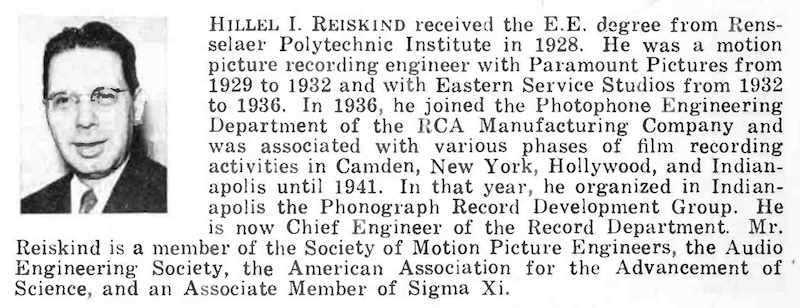
source: RCA Review, June 1949, p.318.
C. Robert Fine 氏は、Reeves Sound Studios でのチーフエンジニア時代に Mercury と密接に関わり始め(Pt. 17 参照)、その後1952年に独立して Fine Sound Studios や Fine Recording のオーナーとなり、生涯を通じて素晴らしい録音を数えきれないほど残しました。AES 学会創設メンバでもあり、1973年に AES フェロー となりました。(JAES 1983年1/2月号に掲載された追悼記事)
Mr. C. Robert Fine became deeply involved with Mercury when he was a chief engineer of Reeves Sound Studios (see: Pt.17). Then in 1952 he became independent and founded his Fine Sound Studios, followed by Fine Recording in 1957, where he had conducted numerous masterpiece recordings. He was also a charter member of the Audio Engineering Society, and became AES Fellow in 1973. (see: obituary article published in the Jan/Feb 1983 issue of the Journal of the AES)
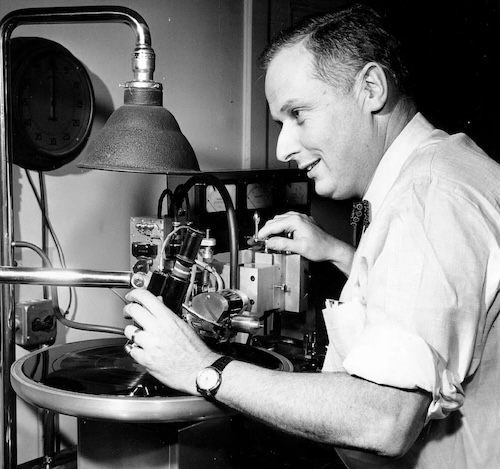
source: producenci (C. Robert Fine)
C. Robert Fine 氏は、Mercury Living Presence での仕事で特に有名ですが、Mercury の社員ではありませんでした。あくまで自身の Fine Sound Studios 〜 Fine Recording の代表でした。
Although Mr. C. Robert Fine is famous for his tremendous work of Mercury Living Presence, he was never a Mercury employee at all. He was simply a founder of his own Fine Sound Studios and Fine Recording.
Mercury との仕事を多くこなしていたために、RIAA 技術委員会での作業を含め、Mercury の代理として技術面で貢献した、つまり Mercury の社外技術コンサルタントであり、Mercury の請負業者であった、というのが真実だ、と Tom Fine さんからコメントをいただきました。
Tom Fine-san (son of C. Robert Fine) also commented that his father was an outside tech consultant as well as a contractor for Mercury, including the work at the RIAA Engineering Committee, on behalf of Mercury as a proxy, because he had worked so frequently and intimately with Mercury.
当時の米国5大メジャーレーベルを代表する彼らは、それぞれのレーベルでの技術部門のリーダー格であり、録音機材の選定やプラクティス、使用する録音特性の選定など社内技術ルールにも責任を持つ立場でした。
Representing the five major U.S. labels of the time, they were the leaders of the technical departments at their respective labels, and were responsible for in-house engineering rules, including the selection of recording equipment, engineering practices, and recording characteristics to be used.
さらに彼らは、もともと NAB / NARTB や AES での規格標準化作業とも密接に関わり合っていました。
In addition, they originally had been closely involved with standardization efforts by NAB/NARTB and AES.
そんな、業界でも一目も二目も置かれる当代きってのエンジニア5人衆が、議論と合意のもと、RIAA 録音再生特性を策定したのです。
These five engineers, who were recognized as ones of the best in the industry, discussed and agreed upon the RIAA Recording and Reproducing Characteristic.
つまり、技術と全く関係ない立場の人が、録音エンジニアの関与を抜きにして勝手に録音再生特性を決定したわけではないのです。
In other words, it was not that someone (in a position completely unrelated to the engineering and technology) decided and formulated the Recording and Reproducing Characteristic, without the involvement of recording engineers.
18.5.6 RIAA Standard Recording and Reproducing Characteristic (Bulletin E1)
彼ら5人が、1年間に渡り、どのような議論を行ったのか、興味は尽きませんが、議事録などが存在したとしても、残念ながら公開されることはないでしょう。
It will be interesting to see what the five of them discussed over the course of the year, but unfortunately, the minutes of their meetings, even if they still exist, will not be made public.
ともあれ、彼らの議論や作業が、“RIAA Standard Recording and Reproducing Characteristic (Bulletin E1)” という規格文書に結実し、1954年1月29日に RIAA 理事会に承認されたことは事実です。
At any rate, it is true that their discussions and work resulted in the document “RIAA Standard Recording and Reproducing Characteristic (Bulletin E1)”, which was approved by the RIAA board of directors on January 29, 1954.
とはいえ、全ての内容をスクラッチから作ったわけではありません。先行して存在していた 1942年NAB規格(Pt.8)〜1949年NAB規格(Pt.10)〜1951年AES標準再生カーブ(Pt.16 セクション 16.4)〜1953年6月NARTB規格(Pt.18 セクション 18.3)などの経緯を参考にしつつ、最終的には 1953年NARTB規格を採用したことになります。
Having said that, not all of the content was formulated from scratch. By referring the history and characteristics of the 1942 NAB Standards (Pt.8), 1949 NAB Standards (Pt.10), 1951 AES Standard Playback Curve (Pt.16 Section 16.4) and 1953 NARTB Standards Pt.18 Section 18.3), they selected the 1953 NARTB Recording Characteristics as a result.
The characteristic selected was one adopted by the NAB as a revision of their earlier standard. It was the outcome of a careful study made by the NAB Engineering Committee of the many recording characteristics then in use. Record engineers participated in this committee action.
選択された特性は、NABが旧規格の改訂版として採用したものであった。これは、当時使用されていた多くの録音特性について、NAB技術委員会が慎重に検討した結果生まれたものであった。レコードエンジニアはこの委員会の活動に参画していた。
The RIAA Engineering Committee, by H.E. Roys, Journal of the Audio Engineering Society, Vol. 16, No. 1, January 1968, pp.18-20残念ながら、1954年1月29日に承認されたオリジナルの Bulletin E1 文書は見つけられていません。
Unfortunately, I have not been able to locate the original Bulletin E1 document, which was approved on January 29, 1954.
現在出回っているものは、“Dimensional Standards of Disc Phonograph Records For Home Use (Bulletin E4)”(オリジナルは 1961年3月16日付承認)の1978年11月6日改訂版に併録されているものです。
The one currently being circulated is the one that was included in the November 6, 1978 revised edition of the “Dimensional Standards of Disc Phonograph Records For Home Use (Bulletin E4)”, which was originally approved March 16, 1961.
Statement of Recording Characteristics
With constant voltage applied to that point in the recording chain where the normal signal has the frequency characteristic that it is desired subsequently to reproduce, the curve of recorded velocity versus frequency shall be that which results from the combination of the following three curves:
通常の信号が後で再生することが望まれる周波数特性を持つ録音チェーンのポイントに定電圧を印加した場合、記録される速度対周波数の曲線は、以下の3つの曲線の組み合わせから得られる曲線とする。
— one rising with frequency in conformity with the admittance of a parallel combination of a capacitance and a resistance having a time-constant of \(t_1\),
— one rising with frequency in conformity with the admittance of a series combination of a capacitance and a resistance having a time-constant of \(t_2\),
— one falling with rise of frequency in conformity with the impedance of a series combination of a capacitance and a resistance having a time-constant of \(t_3\),
— \(t_1\) の時定数を持つ静電容量と抵抗値の並列のアドミタンスにあわせて周波数が上昇するもの、
— \(t_2\) の時定数を持つ静電容量と抵抗値の直列のアドミタンスにあわせて周波数が上昇するもの、
— \(t_3\) の時定数を持つ静電容量と抵抗値の直列のインピーダンスに準拠し、周波数の上昇とともに加工するもの。
The combined curve is defined by:
この3曲線を組み合わせた最終的な曲線は以下のように定義される:
$$\displaystyle N(dB) = 10\log (1 + 4\pi^2f^2t_1^2) – 10\log(1 + \frac{1}{4\pi^2f^2t_2^2}) + 10\log(1 + \frac{1}{4\pi^2f^2t_3^2})$$where \(f\) is the frequency in hertz (cycles per second) and \(t_1\), \(t_2\) and \(t_3\) are as follows:
ここで \(f\) は Hz (cps) で表した周波数、\(t_1\), \(t_2\), \(t_3\), は以下の値とする。
| \(t\) | Fine Groove |
|---|---|
| \(t_1\) | \(75 \times 10^{-6} seconds\) |
| \(t_2\) | \(318 \times 10^{-6} seconds\) |
| \(t_3\) | \(3180 \times 10^{-6} seconds\) |
興味深いのは、1953 NARTB や 1954 改訂 AES では「並列L/R回路」の「アドミタンス」で表現されていた重低域ターンオーバーが、RIAA Bulletin E1(の1978年改訂版E4付属の版)では「直列RC回路」の「インピーダンス」と書かれていることです。
It is interesting to see that the low-bass turnover, which was described as “admittance” of “parallel L/R network” in the 1953 NARTB and 1954 new AES, is described as “impedance” of “series RC network” in RIAA Bulletin E1 (more precisely, the version accompanying the Bulletin E4 revised in 1978).
グラフが 20Hz〜20,000Hz まで描かれている点も、1953 NARTB や 1954 改訂 AES と異なります。
The plotted graph shows the range from 20Hz to 20,000Hz, which is also different from those of 1953 NARTB and 1954 new AES.
そして、この文面は、1964年NAB規格(こちらは再生用規格のみ)のものとほぼ同じになっています。
Furthremore, the above text is almost identical to that of the 1964 NAB Standard (which contains reproducing characteristic only).
よって、Bulletin E4 (Revised: November 6, 1978) 付属の Bulletin E1 は、1954年オリジナルの Bulletin E1 の文面ではなく、後年改訂されたものではないか?と考えることもできそうです(詳細不明)。
Therefore, it seems likely that the Bulletin E1 (accompanying Bulletin E1, revised: NOv. 6, 1978) is a later revision, not the original Bulletin E1 from 1954 (details unknown).

source: “RIAA Dimensional Standards: Bulletin No. E 1: Standard Recording and Reproducing Characteristics”
1954年1月29日に策定された、RIAA標準録音再生規格文書(の1978年11月6日改訂版)に掲載された、RIAA録音再生カーブのグラフ
グラフの上限が 20,000Hz となっている
This graph from the 1978 Revision is defined between 20Hz and 20,000Hz
一方、1960年代末から製造が始まったと思われる、半導体を使った Westrex RA-1703 アンプ(RIAA録音イコライザ内蔵)に付属の ドキュメント には、RIAA録音特性についての解説があり、こちらに書かれているものが、オリジナルの Bulletin E1 から転記された可能性があります。こちらの文言は、1953 NARTB の表記と同一で、時定数3,180μsカーブは「並列L/Rネットワーク」と書かれていますし、グラフは 30Hz〜15,000Hz までとなっています。
Here’s another intersting document, which supposedly came with Westrex RA-1703 Amplifier (probably from late 1960s, using transistors, RIAA recording equalizer included) contains the description of RIAA Recording Characteristic. This text is very similar to 1953 NARTB Standards, with the 3,180μs curve described as “admittance of a parallel L/R network”, and with the graph domain from 30Hz to 15,000Hz. Is this Westrex document a quote from the original RIAA Bulletin E1 documentation?
ただし、この文書で RA1703 と書かれている箇所が、不自然にイタリック体になっているため、より古い Westrex インプットアンプのドキュメントを流用したのか、あるいは RA-1703 用当該ドキュメント制作時にオリジナル RIAA Bulletin E1 の記載を流用したのか、はたまた RIAA Bulletin E1 ではなく 1953 NARTB の記載を流用したのか、などの可能性もあります(詳細は不明)。
However, it is also worth mentioning that the term “RA1703” in the document is printed with unnaturally italic fontface. So it could be either that this document was an appropriation of an older document for older Westrex amplifiers, or that the description of the Bulletin E1 was used for this document, or that the writer quoted the 1953 NARTB Standards instead of 1954 RIAA Bulletin E1 (details still unknown).

source: “Appendix C: The R.I.A.A. Frequency Response Characteristic for Disc Recording”.
Westrex RA-1703 インプットアンプ(RIAA録音イコライザ内蔵)の付属文書より
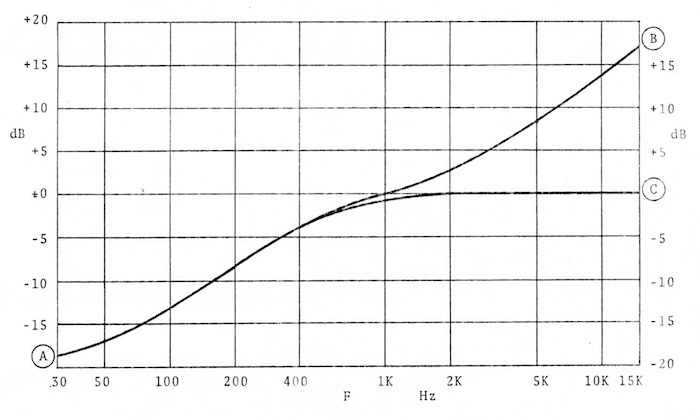
source: “Appendix C: The R.I.A.A. Frequency Response Characteristic for Disc Recording”.
Westrex RA-1703 インプットアンプ(RIAA録音イコライザ内蔵)の付属文書より
グラフの上限が 15,000Hz となっている
18.6 Example of RIAA Recording / Reproducing Equalizers at Studio
1953 NARTB / 1954 改訂AES / 1954 RIAA 策定後、スタジオで使用されていたプロ仕様の(特定の録音システム専用ではない)「汎用」録音用フォノイコライザの典型例として、Cinema Engineering 社のユニットがあります。
After the formulation of 1953 NARTB / 1954 new AES / 1954 RIAA Standards, recording equalizers for professional use, such as the units by Cinema Engineering came along. These are “generic” equalizers, meaning “not for a particular recording system”.
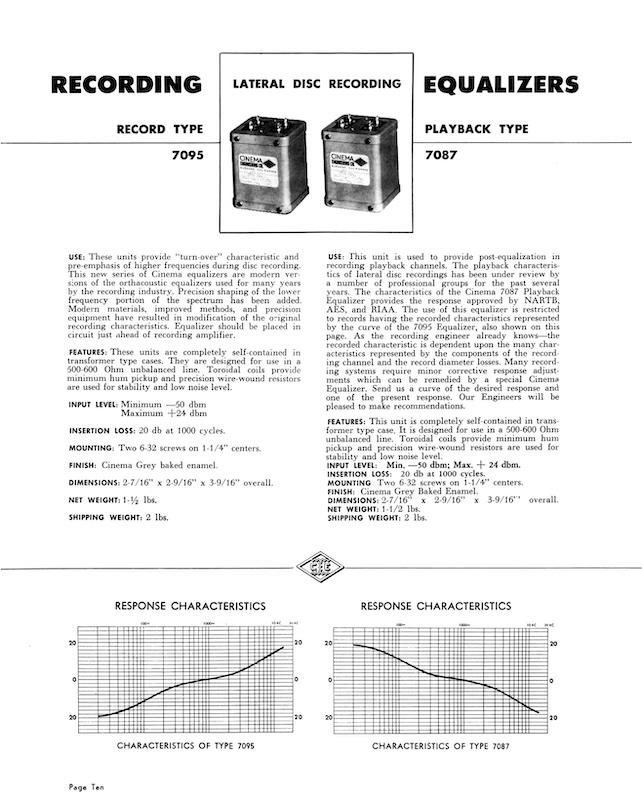
source: Cinema Engineering Company Catalog No. 12EC (possibly in 1954?)
Type 7095 が録音EQ、Type 7087 が再生EQ です。写真の通り、電源を必要としないパッシブLRCイコライザユニットとなっており、挿入損失は 20dB at 1,000Hz とされています。インピーダンスが 600Ωというのがプロフェッショナル仕様らしいところです。
The Type 7095 is the recording equalizer, while the Type 7087 is the reproducing equalizer. As you can see in the photo, these are passive LRC equalizer units, without the need of power source. The insertion loss is said as: 20dB at 1,000 cycles. The impedance of 600Ω is typical of professional specifications.
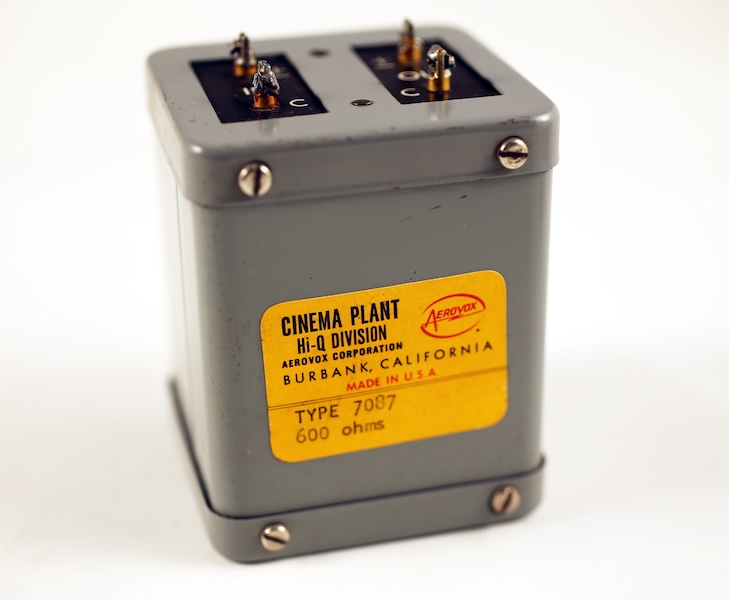
Cinema Engineering Type 7087 Playback Equalizer Unit
photo courtesy of Nicholas Bergh.
Nick さん提供、Cinema Engineering Type 7087 再生用フォノイコライザユニットの貴重な実物写真
本稿前半で触れた通り、フィードバックカッター導入により、カッターヘッドのフラット特性が得られるようになったため、全周波数帯域で単純に RIAA 録音特性、RIAA 再生特性を単体で実現するようになっています。
As we have seen in the early section(s) in this article, the advent of feedback cutters enabled to obtain flat frequency response of the cutterhead. This is why such recording equalizers as Cinema Engineering 7095 simply take care of disc recording equalization alone for the entire frequency range.
録音スタジオで RIAA 録音特性が浸透するに従って、このような録音イコライザユニットが録音システムのシグナルパスに挿入され、そしてスタジオでの試聴時や再生チェック時には、このような再生イコライザユニットが使われていたそうです。
As the RIAA Recording Characteristics became more prevalent in recording studios, such recording equalizer units were inserted into the signal path of recording systems; and these playback equalizer units were used during studio listening and soundchecking.
その他、Fairchild、Gotham/Grampian、Western Electric、Neumann など、その他の録音システムに内蔵された録音イコライザについては、次回触れようと思います。
Other recording equalizers built into other recording systems, such as Fairchild, Gotham/Grampian, Western Electric and Neumann, will hopefully be covered in the next part of my article.
18.7 The summary of what I got this time / 自分なりのまとめ
Pt.0 公開から1年2ヶ月、やっと本丸の1つである RIAA 録音再生特性そのものに到達しました。
A year and two months after I published Pt.0 of this entire article, I have finally reached one of the main focuses, the RIAA Recording and Reproducing Characteristics themselves.
調べれば調べるほど、現場のエンジニアの矜持が感じられるというか、Pt.16 のサファイアグループ〜AESでみたように、技術者的感覚に基づいて、標準化を目指し、レコード業界や各種関連団体との連携をとりつつ、規格が策定されたことが感じられました。
The more I looked into it, the more I felt the pride of the engineers in the field at the time, or as I wrote in Pt.16 (from Sapphire Group to the Audio Engieering Society), the more I felt that the standards (1953 NARTB, 1954 new AES, 1954 RIAA) were established based on engineers’ sense and in cooperation with the record industry and related organizations, with the aim toward standardization.
さてさて、今回の内容をざっくりまとめると、こんな感じでしょうか。
…so, the rough summary of my understanding in this Pt.18 article would be something like this:
1950年代前半から、フィードバックカッターヘッドが民生用レコードのカッティングで使用されるようになり、カッターヘッド自体がほぼフラット記録特性を獲得した。
From the early 1950s, feedback cutterheads began to be used in cutting consumer records,and the cutterheads themselves acquired nearly flat recording characteristics.
それにより、かつてはカッターヘッドの特性と録音EQの合計で録音カーブを制御していたのに代わり、録音カーブ自体を録音EQ単体で実現可能になった。
This made it possible to realize the recording curve itself with the recording EQ alone, instead of controlling the recording curve with the sum of the cutterhead’s characteristics and the recording EQ.
1953年6月19日に承認された、放送局向けの NARTB Recording and Reproducing Standards は、1942年版および1949年版NAB規格を置き換えるもので、マイクログルーヴ盤や45回転盤も規格に明記された。また、高域プリエンファシスが強すぎると批判にさらされてきた録音カーブは、RCA Victor New Orthophonic 準拠のものに改訂された。
The NARTB Recording and Reproducing Standards for broadcasters, approved on June 19, 1953, replaced the 1942 and 1949 NAB Standards. Microgroove and 45 rpm records were also specified in the standards. The recording curve, which had been criticized for having too much high-frequency pre-emphasis, were revised to conform to the RCA Victor New Orthophonic characteristics.
オーディオ工学の学会 AES が1953年12月21日に暫定提唱規格として承認し、論文誌上で公開した Standard Playback Characteristic for Lateral Disc Recordings は、1951年に AES が発表していた標準再生カーブの改訂版であった。1953 NARTB すなわち New Orthophonic カーブに完全に対応する再生特性となっていた。1954年6月15日に正式に承認され、AES: TSA-1-1954 という文書となった。
The tentative draft of the Standard Playback Characteristic for Lateral Disc Recordings, approved on December 21, 1953 then published in the Journal of the Audio Engineering Society, was a revision of the AES Standard Playback CUrve published in 1951. This reproducing characteristics were fully compatible with the 1953 NARTB (thus New Orthophonic) curve. It was officially approved on June 15, 1954 and became the document AES: TSA-1-1954.
米レコード業界団体RIAAの主導で、RIAA Standard Recording and Reproducing Characteristic は、1954年1月29日に正式承認された。のちに RIAA Bulletin E1 という名称が与えられた。これも録音特性は 1953 NARTB すなわち New Orthophonic カーブと完全に同一のものであった。策定したのは、レコード業界内の緊密な技術協力体制を確立するために設立され、当時の業界を代表するエンジニア達で構成された、RIAA 技術委員会であった。
The RIAA Standard Recording and Reproducing Characteristic, developed by leading engineers at the time under the direction of the RIAA, the U.S. recording industry association, was officially approved on January 29, 1954. It was later given the name RIAA Bulletin E1. It was also completely identical in recording characteristics to the 1953 NARTB, i.e. New Orthophonic curve. It was formulated by the RIAA Engineering Committe, which was formed because the industry needed the closer cooperation in the record industry.
それまでの録音再生カーブは、グラフプロットのみの提示であることが多かったが、この3規格においては、カーブの定義が電気回路のアドミタンスやインピーダンスを使った数学的な表記で行われた。そこで重要になるのが「時定数」である。
Until these three curves appeared, recording and reproducing curves were often presented only as graph plots. But in these three standards, the curves were defined in methematical terms, using the admittance and impedance of electric circuits. “Time constant” is therefore important.
放送局業界である NAB、オーディオ工学の学会である AES、米レコード製造元らの業界団体である RIAA、これらの団体は、所属メンバも重複していたのはもちろん、互いに連携しあい、標準化を目指していた。
NAB being a broadcasting industry organization; AES being an audio engineering society; RIAA being a trade association of U.S. record manufacturers. These three organizations not only had overlapping memberships, but also collaborated with each other in their efforts to standardize the industry.
次回は、RIAA 規格策定後、業界や各レーベルがどのように対応したか、を追っていきます。また、その頃にスタジオで使われていた機材などについてもみていきます。
My next post will feature the situation of how the industry and each label reacted to the standardization, after the RIAA Standards were formulated. Also, it will feature the equipments used during the transition period.
» 続き / Sequel: “Things I learned on Phono EQ curves, Pt.19” »

